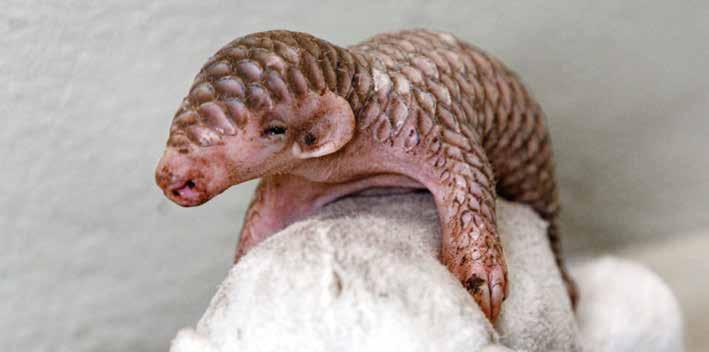
 of the genus Bombina and long-eared hedgehogs. pipe dream or is there any science behind it?
of the genus Bombina and long-eared hedgehogs. pipe dream or is there any science behind it?

About us
MAGAZINE PUBLISHED BY
Peregrine Livefoods Ltd
Rolls Farm Barns
Hastingwood Road
Essex
CM5 0EN
Print ISSN: 2634-4700
Digital ISSN: 2634-4688
EDITORIAL: Thomas Marriott

DESIGN: Scott Giarnese
Amy Mather
Subscriptions
Follow us

I’m not sure whether it’s a trend amongst all exotic animal lovers, but I for one, am incredibly glad that spring is here. Not only do the UK’s reptiles and amphibians begin to stir around this time of year (although there have been some frightening cases of amphibians spawning dangerously early this year!) but a lot of the events and conferences begin around March. As I write this, we are preparing to visit the annual Advancing Herpetological Husbandry/British Herpetological Society Conference. If the event is anything like last year, I’m sure it’ll be fantastic and you should check out our website and socials for coverage of the conference.
Some of you may have noticed we are now using far more guest writers’ articles. Managing this project whilst also seeing the platform grow and improve is a mammoth task. Luckily, exotics keepers are a passionate bunch! I have been blessed with the support of those wishing to share their stories with the wider community. By providing a platform for hobbyists, scientists and industry professionals to voice their expertise, we hope that EK Magazine can share new perspectives and
Finally, the “Members Area” launched last month, giving subscribers free online access to back-issues of the magazine. We should have contacted everyone with an annual or 6-month subscription by now, but are currently working on a way to give new subscribers instant-access. If you have not received your code to become a member, but hold a 6-month or annual subscription, please also drop me an email.
Thomas Marriott
Every effort is made to ensure the material published in EK Magazine is reliable and accurate. However, the publisher can accept no responsibility for the claims made by advertisers, manufacturers or contributors. Readers are advised to check any claims themselves before acting on this advice. Copyright belongs to the publishers and no part of the magazine can be reproduced without written permission.
Front cover: Puff adder (Bitis arietans)

Right: 'Chubby frog' (Kaloula pulchra)

CONTACT US
ENQUIRIES
PERMISSIONS
EDITORIAL
hello@exoticskeeper.com SYNDICATION &
. . . . . . . . . . . . . . . . . . . . . . . . .
thomas@exoticskeeper.com ADVERTISING advertising@exoticskeeper.com
‘Best Aquarium Fish Food’









As voted by readers of Practical Fishkeeping magazine
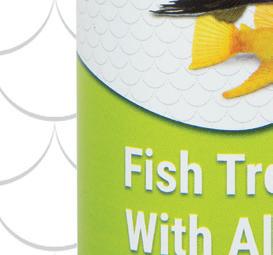
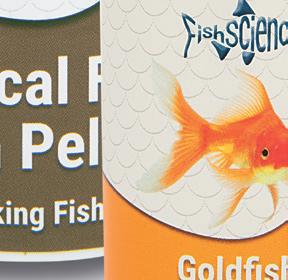


Aquarium Fish Foods with Insect Meal
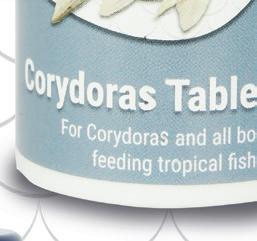
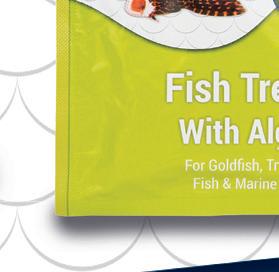



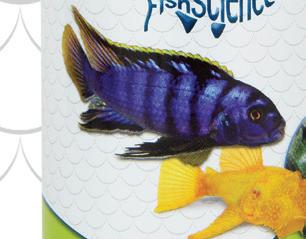


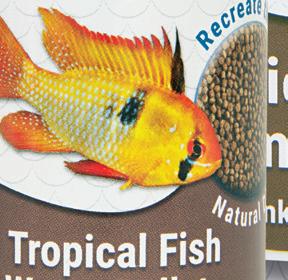

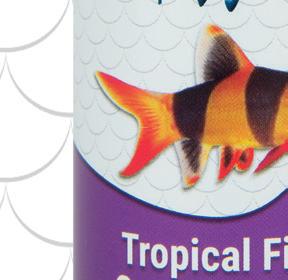
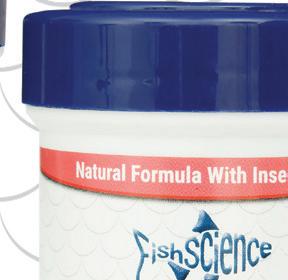
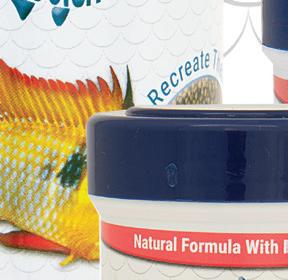


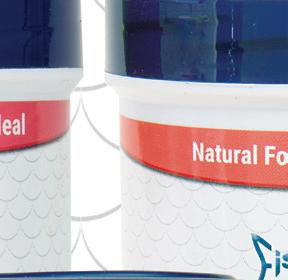




Uses cultured insect meal to recreate the natural insect based diet that most fish eat in the wild.
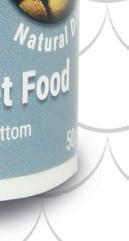








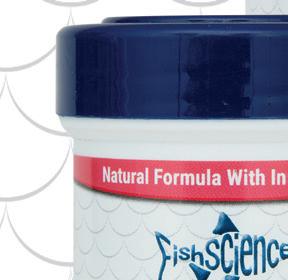
Easily digested and processed by the fish resulting in less waste.








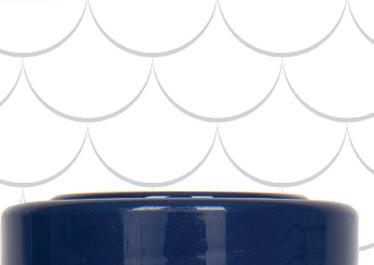

Environmentally friendly and sustainable.

www.fishscience.co.uk
02 06 16 02 EXOTICS NEWS
The latest from the world of exotic pet keeping.
06 THE KEEPER OR THE KEPT? The story behind tarantulas with pet frogs.

14 SPECIES SPOTLIGHT Focus on the wonderful world of exotic pets. This month it’s the Viper gecko (Hemidactylus imbricatus).

15
24 32 41
FISH SCIENCE
With Dr David Pool.
16 PRICKLY PETS
Do hedgehogs and African pygmy hedgehogs have anything in common?
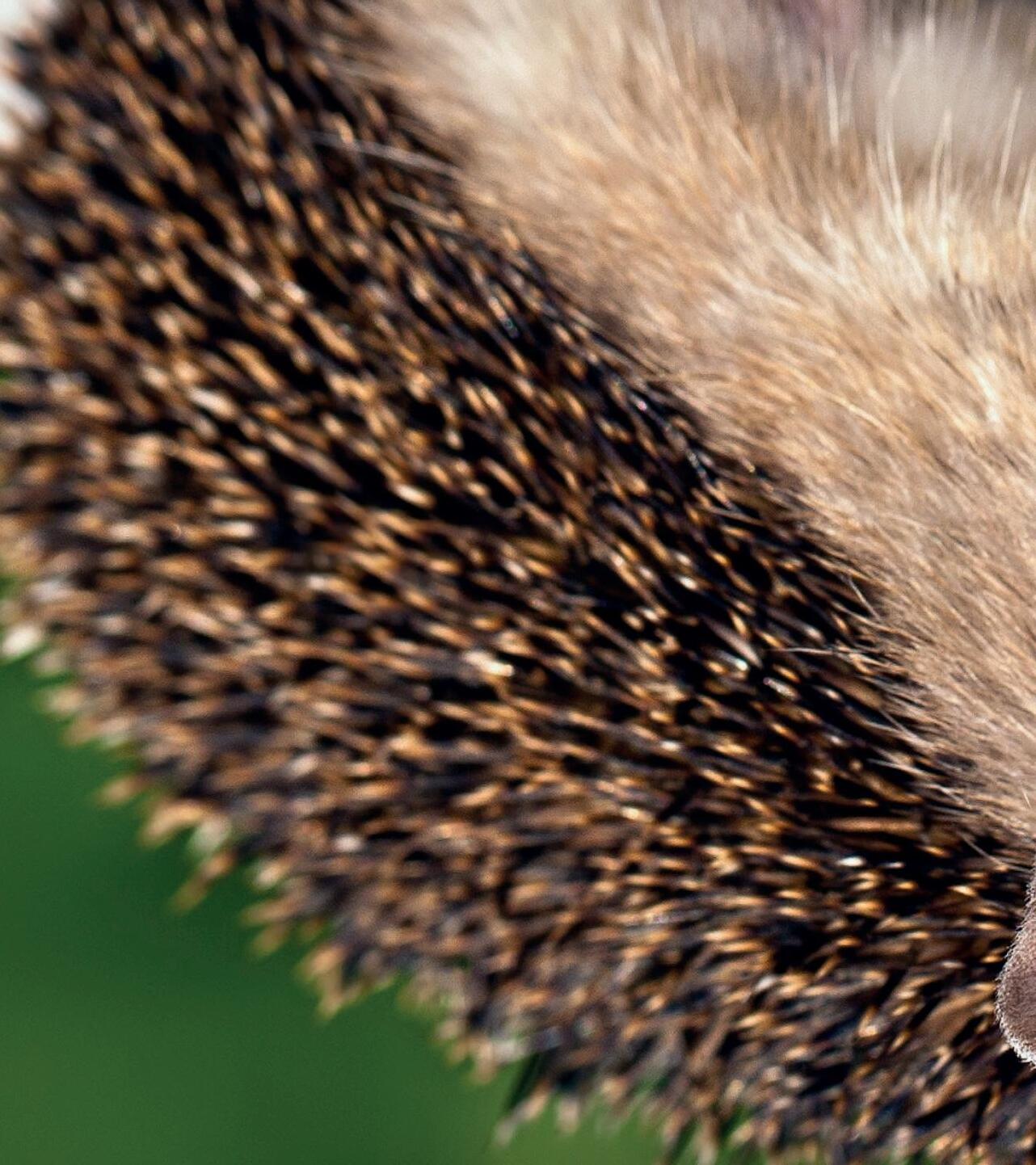
24HERPING THE GLOBE: Expedition Morocco. From fire salamanders to cobras, what can't be found in this North African gem?
32AMPHIBIANS WITH TWO SIDES

An introduction to Fire-bellied toads, as well as the care and breeding of the genus Bombina.

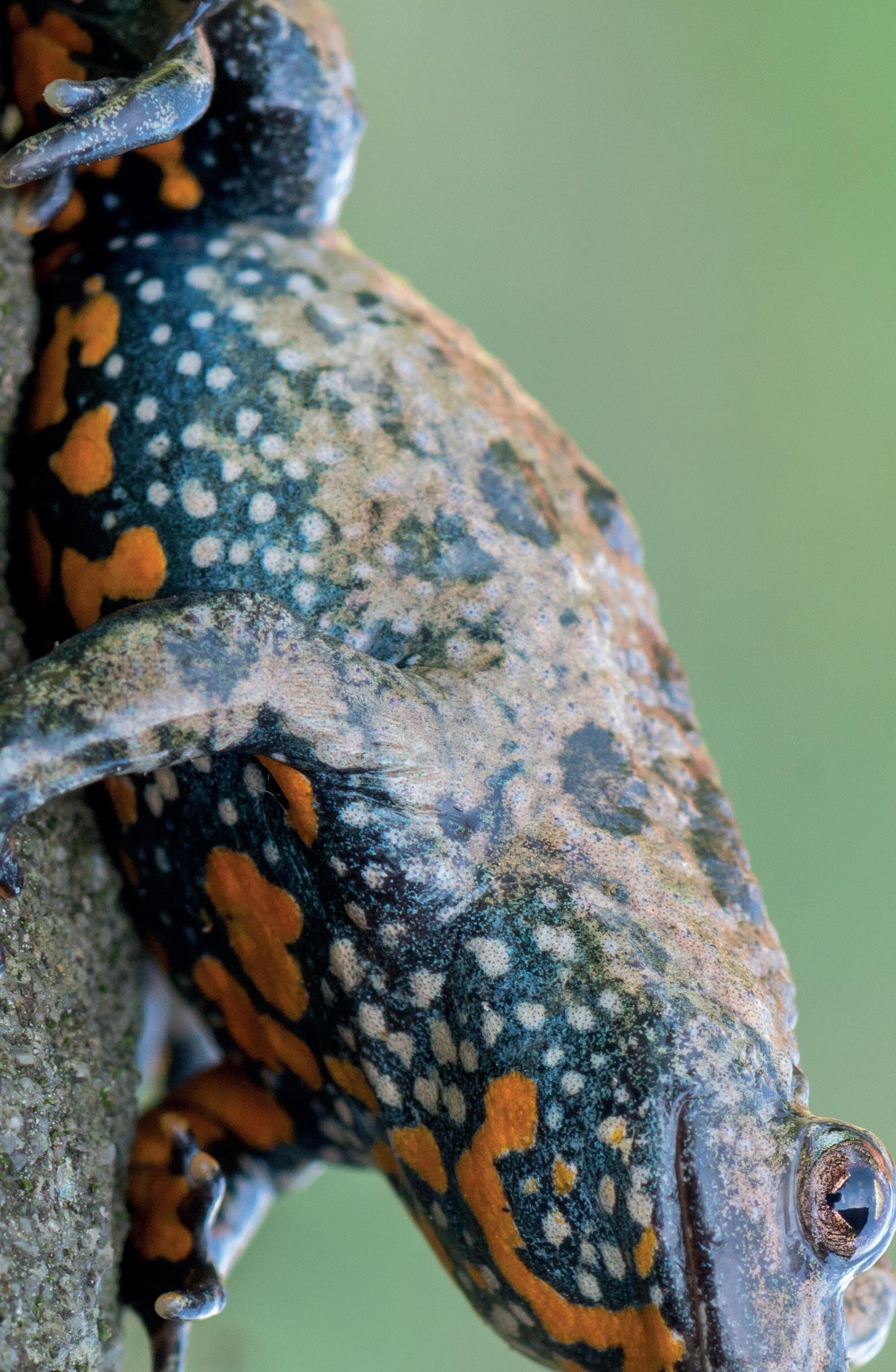
41 KEEPER BASICS: Outdoor Keeping.
45 FASCINATING FACTS Did you know...?
46 REHOME ZONE
Can you help these exotic pets find a new home?
EXOTICS NEWS
The latest from the world of exotic animals
“The Vivarium” Re-opens
Manchester Museum re-opened its doors to visitors in February following a £15m refurbishment. The museum, which had been closed since June 2021, hosts the “Vivarium” which houses a large collection of critically endangered amphibians, mostly from Costa Rica. Museum Director Esme Ward told Mancunian Matters: “We are absolutely thrilled to have opened our doors once again, we welcomed over 11,000 visitors during our reopening weekend, which is remarkable. Our visitors are what make the museum what it is and it’s not been the same without them – it was such a joy to see the building full of excited faces.”
have of the biodiversity of TimorLeste. 10 individuals of Cyrtodactylus santana were discovered in the Nino Konis Santana National Park by Chan Kin Onn and fellow researchers. Situated between Wallace’s Line and Lydekker’s Line, Timor-Leste is a hotspot for biodiversity with high levels of endemism. Previously occupied by Indonesian militia, Timor-Leste won its independence in 2002 but sadly lost immense areas of forest and is still affected by high rates of poverty. The discovery of the bent-toed gecko, Cyrtodactylus santana, may prompt more interest in studying and protecting the country’s fauna.
British Veterinary Association publishes stance on “Non-Traditional Companion Animals”

in the UK, claiming that the term “non-traditional companion animal” is already extremely problematic. Exotics Keeper Magazine reached out to the association and was presented with source material from lobbyist organisations, “Born Free” and “World Animal Protection”. Chris Newman of the Reptile and Exotic Pet Trade Association and Founder of the National Centre for Reptile Welfare said: “it’s not a surprise to me in the slightest and it affirms the BVA’s position. Both [Born Free and World Animal Protection] are animal rights groups, not animal welfare… If we genuinely care about animal welfare, then we need to be able to measure the overall welfare of all animals kept as companions, rather than trying to create artificial terms for taxa such as non-traditional, traditional, exotic, domesticated and so forth.” Full coverage of this story will be available on our website soon.
New gecko species described on Timor-Leste



A new species of bent-toed gecko has been officially described, hinting at the limited knowledge scientists
The British Veterinary Association have published their stance on “NonTraditional Companion Animals”. In recent councils, the BVA has seemingly supported the idea of implementing a “positive list” model in the UK. According to the association, the 2022 Voice of the Veterinary Profession survey found that over eight in ten vets (81%) were concerned that the welfare needs of NTCAs were not being met, with the most cited welfare issues being ‘irresponsible animal ownership’ (82%), ‘irresponsible breeding or sourcing’ (11%), and ‘lack of specialist veterinary care’ (10%). Vets who treat NTCAs report that over half (58%) of the NTCAs they see do not have their five animal welfare needs met.
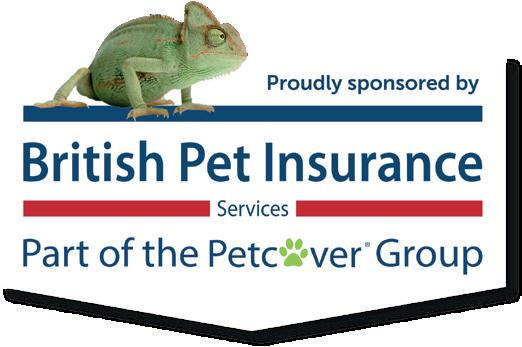
Chester Zoo welcomes birth of rare lemur
Keepers at Chester Zoo are celebrating the birth of a Coquerels sifaka (Propithecus coquereli). The baby lemur and its two parents are the only three members of the species Make
The data has been met with some scepticism from professional groups representing those who keep exotics
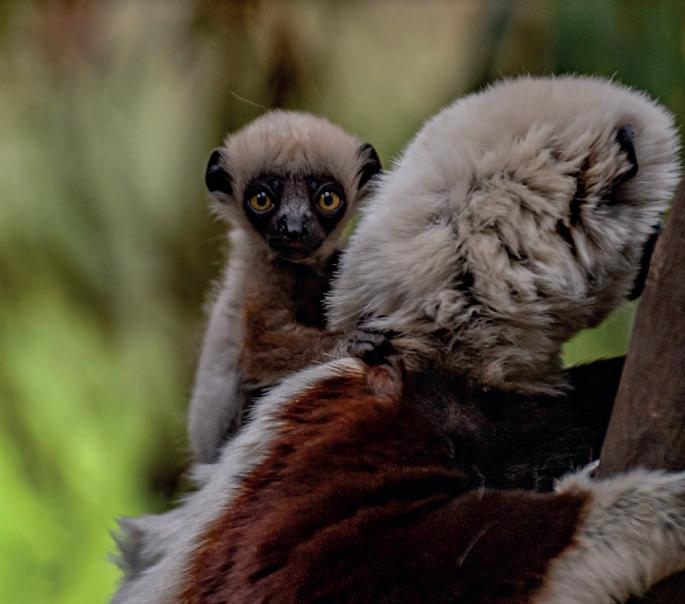
2 APRIL 2023 Exotics News
insurance.
sure you catch our exotic
©Chester Zoo
©Chan Kin Onn
to be maintained in a UK collection and are three of only seven in Europe. Found only in the treetops of northwest Madagascar, the Coquerel’s sifaka lemur population has suffered an 80% decline in just 30 years due to widespread deforestation. As a result, the world’s authority on the state of nature, The International Union for the Conservation of Nature (IUCN), upgraded the species to its highest conservation priority in 2018 and listed the primates as critically endangered in the wild.
Mike Jordan, Director of Animals and Plants at Chester Zoo, added: “The birth of a Coquerel’s sifaka in Europe is a real landmark moment for conservation and, importantly, has kickstarted the endangered species breeding programme in European zoos for the species – which could be the lifeboat that prevents them from becoming wiped out completely. Mass deforestation has swept across the island of Madagascar and it has lost up to 90% of its forests, taking with it thousands of species. But we refuse to let the devastation continue and our conservationists have helped our partners Madagasikara Voakajy – an NGO based in the heart of the island – to develop an official protected area spanning 27,000 hectares of forest, which is home to some of Madagascar’s most precious species.”
there are still areas of Australia with hidden secrets.”

Brett Turnbull, Ranger in Charge of the Whitsundays region was on the trip in which the species was discovered. “This is an exciting discovery, and an important one, because we base our management of these islands on their biodiversity values. Knowing which species occur where, and finding species restricted to single islands, informs our management of fire, invasive species and other threats,” said Mr Turnbull.
So far, 30 specimens have been found and recorded on the boulder-strewn island but ongoing research hopes to map the population size with more accuracy. The geckos appear to have survived island fires by hiding amongst the rocks, but researchers believe they could be subject to other threats. Asian house geckos (Hemidactylus frenatus) are an invasive species that have established themselves on the mainland in Townsville and conservationists are worried that they may easily adapt to life on the island too, outcompeting the leaf-tailed geckos. Poaching of Phyllurus species is also known to occur in nearby areas.

New leaf-tailed gecko species discovered
A new species of Australian leaf-tailed gecko has been discovered on a small island on the Great Barrier Reef. The “Scawfell Island leaf-tailed gecko” was described by James Cook University Professor, Dr Conrad Hoskin last month. Dr Hoskin discovered the gecko during a survey with Queensland Parks and Wildlife Service & Partnerships.
“It is incredible to still find large and spectacular new species in this day and age,” said Dr Hoskin. “The fact that this gecko remained undiscovered to science shows that
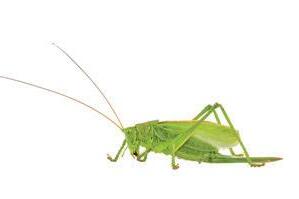
Whipsnade welcomes African wild dogs
ZSL Whipsnade Zoo has recently welcomed three critically endangered African wild dogs (Lycaon pictus) to their collection from West Midlands Safari Park. Once a widespread species with a total population estimate of 500,000, the African wild dog has seen numbers plumet. Now, BBC Wildlife Magazine reports that there are fewer than 6,000 left in the wild, belonging to around 700 individual packs. It is thought that the acquisition of Earl, Elvis and Einstein by Whipsnade Zoo will help establish a new captive breeding population in the UK.

3 APRIL 2023 Exotics News
Get a quote at britishpetinsurance.co.uk or call us on 01444 708840
©Conrad Hoskin
©ZSL Whipsnade Zoo
First pangolin is born in a European Zoo
A critically-endangered Chinese pangolin (Manis pentadactyla) has been born at Prague Zoo. The parent pangolins, female, Run Hou Tang and male, Guo Bao, were obtained from Taipei Zoo in April 2022. Pangolins are notoriously difficult to keep and breed in captivity and Prague Zoo became only the second zoo in Europe to hold these peculiar and critically endangered mammals. Their highly-specialised diet requires keepers to provide bee larvae paste to give them enough nutrients to breed. Pangolins are the most illegally trafficked mammals in the world and as a result, all nine species have suffered immense population declines. Seven of these species are endangered or critically endangered, with the Chinese pangolin being one of the rarest.

“We are incredibly happy, but at the same time we do realize that the following days might be critical,“ warns the Prague Zoo director Miroslav Bobek. "The female pangolin Run Hou Tang that we got from the Taipei Zoo had already raised offspring, so the chances [of success] are relatively high.“
At the time of writing, the young pup is still healthy and has recently been sexed, as keepers confirm it is a female. “The pangopup is strong and very active,” said keeper David Vala. “The footage from the camera placed in the “burrow” shows it is moving and regularly suckles its mother’s milk. However, it has yet to gain weight and is still in the most critical period. We are in constant contact with our Taiwanese colleagues and will artificially rear it if necessary.”
ON THE WEB
Websites | Social media | Published research
Each month we highlight a favourite website or social media page
THIS MONTH IT’S: AMPHIBIAWEB It's their spring 2023 campaign! AmphibiaWeb is run on a shoestring budget and they are grateful to the 1.2% of AmphibiaWeb users who already donate to support the site. If you love AmphibiaWeb and have the resources to make a donation of any amount, please consider making a gift today.
www.amphibiaweb.org

4 APRIL 2023
Exotics News
©Zoo Prahia

THE KEEPER OR THE KEPT?
The story behind tarantulas with pet frogs.

6
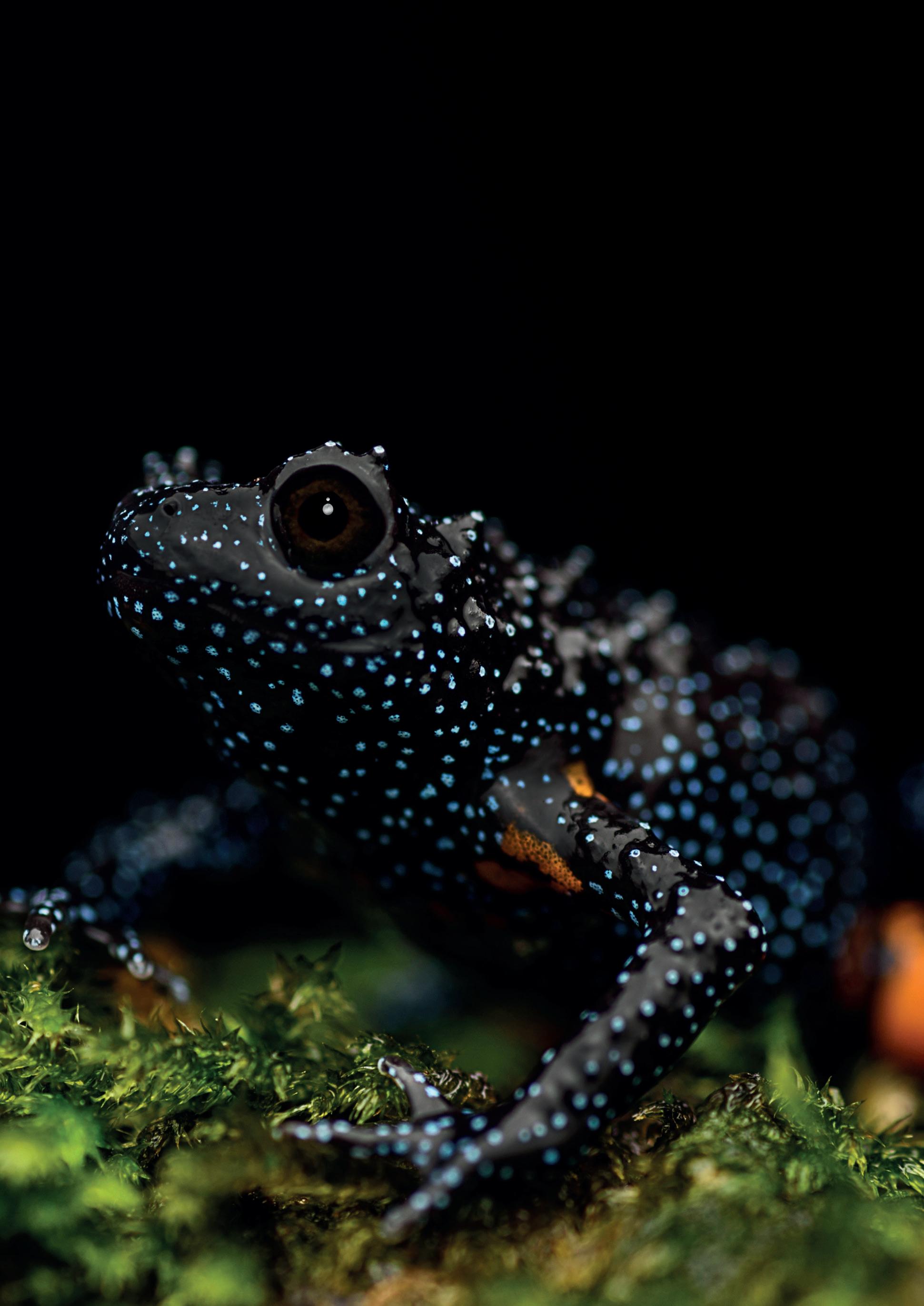
Every now and again a bizarre scientific story captures the attention of the masses. In some cases, these stories seemingly resurface every few years for a bewildered generation. Usually, these waves of intrigue are spurred on by social media trends and the latest story to go viral on TikTok is that of giant tarantulas keeping “pet” frogs. Symbiotic relationships are common in the animal kingdom and therefore, this anthropomorphic tale of two unlikely friends seems reasonably plausible. Is this a far-fetched Pixar-esque an anthropomorphic pipe dream, or is there some science behind the story?
The frog and the spider
The “pet frogs” that are frequently seen in close proximity to tarantulas are generally from a specific group of amphibians called “Microhylidae”. Microhylid frogs are commonly known as “narrow-mouthed frogs.” There are 683 species of these frogs found all over the world. Some are beautifully patterned and grow up to 10cm long while others are barely visible creatures, never exceeding 10mm in length. Some species are frequently kept in captivity such as the very charismatic “chubby” frog (Kaloula pulchra). Most Microhylids are very small, terrestrial frogs that occupy leaf litter in tropical and subtropical forests, although it is almost impossible to summarise the family. Some thrive in arid
landscapes, burrowing beneath the soil for large parts of the year whilst others are arboreal with toe pads and breed in tree trunk holes in the forest canopy.
Just as the “pet frogs” are from a very diverse group of animals, so are the tarantulas. Theraphosidae contains around 900 different species of tarantula and they can be found across most warm climates. Although most records of spiders with “pet” frogs focuses on one genus of South American tarantula, the family is extremely broad and convergent evolution is reasonably common, indicating this phenomenon may not be restricted to a particular species or genus.
8 APRIL 2023 The Keeper or the Kept?
Symbiosis
The first published observation of a “spider keeping a pet frog” dates back to 1989. Whilst studying entomology in Peru, Reginald Crocraft and Kieth Hambler observed a “close association” between a Microhylid frog (Chiasmocleis ventrimaculata) and a Colombian lesser back spider (Xenesthis immanis). They claimed that the spider seemed to allow the frog to share its burrow, despite being perfectly capable of killing and feeding on the frog. They even observed the spider seemingly moving its legs to allow the tiny amphibian to pass in and out of the burrow. Both species are nocturnal and when the spider would emerge from its hole to hunt, the frog would follow.
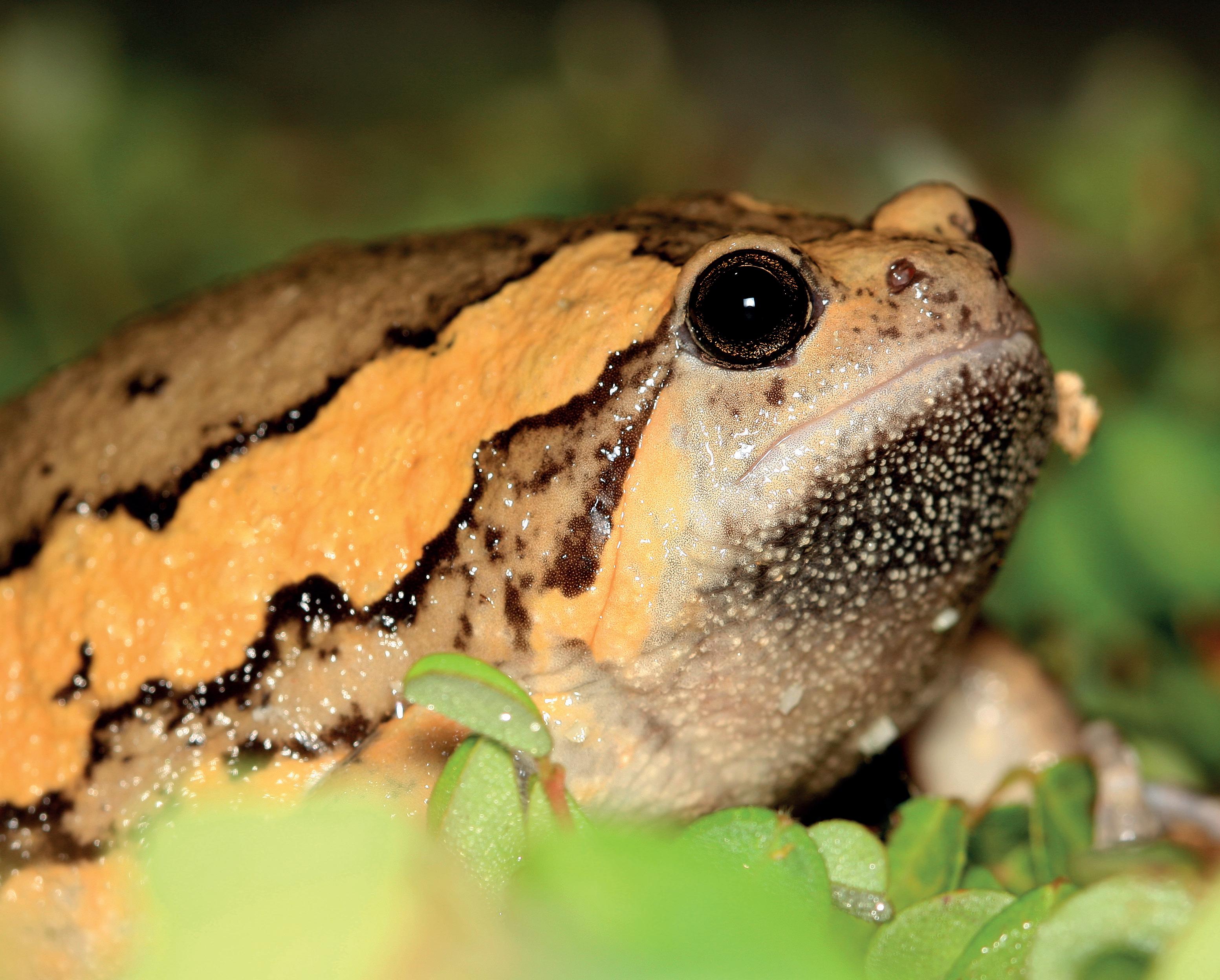
Initially, it was thought that the spider was simply ignoring the frog. Since Crocraft and Hambler’s discovery, others have observed young spiders picking up the tiny frogs, examining them with their mouthparts and putting
them back down again, suggesting that the frogs may have some form of chemical defence. The frog benefits from the protection of the spider, while the spider must tolerate its new tenant. This form of relationship is called commensalism, where one organism benefits from the other one but neither is harmed. However, further studies suggest that there may be further benefits for the unlikely duo.
It appears that the spiders choose not to eat the frogs as they also offer protection for the spiders’ eggs. The frogs will prey on tiny insects that are too small for the tarantula to fend off. These little bugs (including ants, mites, etc) are attracted by the leftovers of the spiders’ much larger prey but would undoubtedly enter the spiders’ burrow to feed on its egg sac and newly hatched offspring. Because it seems that both species are benefitting from the symbiotic relationship, it is described as mutualism. Across the
9 APRIL 2023 The Keeper or the Kept?
Kaloula pulchra
animal kingdom, inter-species mutualistic relationships are well-documented. In extreme cases, these relationships have prompted some species to become entirely reliant on another species for survival.
In 2002, Jolene Csakany suggested that Crocraft and Hambler’s original description of Xenesthis immanis may be incorrect. The “Colombian” lesser back spider’s range does not stretch as far south as Peru and so Csakany set out to find out which species actually exhibit these strange behaviours. She discovered the black spider referenced in 1989 was possibly an undescribed species of chicken spider (Pamphobeteus spp.) She tested this theory by taking the skin of a humming frog and putting it onto two different bullfrog species (Leptodactylus) (both species that the tarantula would usually prey upon) and discovered that the tarantula would not eat the animal with the humming frog’s skin. This supported the theory that the frog’s chemical compounds within its skin help the tarantula identify friends from food.

All around the world
As the story of symbiotic relationships between Arachnids and amphibians engulfed the curiosity of entomologists and herpetologists internationally, new cases are continuing to be unearthed each year. Perhaps the most startling came in 2008 from Rameshwaran Island, off the southeast coast of India. Researchers reported an “unusual” relationship between another Microhylid, the Sri-Lankan painted frog (Uperodon taprobanicus) formerly, Kaloula taprobanica and a member of the Poecilotheria genus of tarantulas. Any invertebrate
keeper will know just how popular Poecilotheria are in captivity. They include the Gooty-sapphire ornamental tarantula (P. metallica), ornate tiger tarantula (P. ornata) and the Indian ornamental tarantula (P. regalis). Poecilotheria is known for being extremely aggressive, arboreal spiders that pack reasonably potent venom. Yet, despite their unwelcoming characteristics, they have been recorded sharing a hole with the rather unassuming bullfrog.
In 2009 Poecilotheria ornata and Poecilotheria subfusca were also reported to seemingly have close relationships with the Microhylid frog Uperodon nagaoi The frogs and the tarantulas were recorded sharing tree holes, many of which contained eggs and/or juveniles of the spider, the frog or both “partner” species. The researchers found that the Poecilotheria tarantulas would actively protect the frogs’ eggs from predatory geckos ( Hemidactylus depressus ). As the eggs (and frogs) are ultimately defenceless without the spiders and the spiders’ eggs are defenceless against small insects, there is reason to believe the two species are reliant on one another.
Herpetologists and Entomologists are also startled by the fact that both cases of mutualism are enacted by species from different lineages on two entirely different continents. Other scientists have also recorded some form of association between the Tungara frog ((Engystomops pustulosus (formerly Physalaemus pustulosus)) and tarantulas of the genus Aphonopelma in Mexico. Whilst research into the topic is still developing, every observation indicates that this relationship has evolved multiple times across the world.
10 APRIL 2023
Poecilotheria subfusca
A friendly bunch
Colombian lesser back spider
Xenesthis
The Colombian lesser back spider is a medium-sized tarantula from Colombia and Venezuela. They are generally black with a purple/pink starred pattern. Their striking appearance makes them reasonably popular in captivity, where they are reported to be quite skittish. Scientists have reported a close association between this species and two distinct species of Microhylid frog.

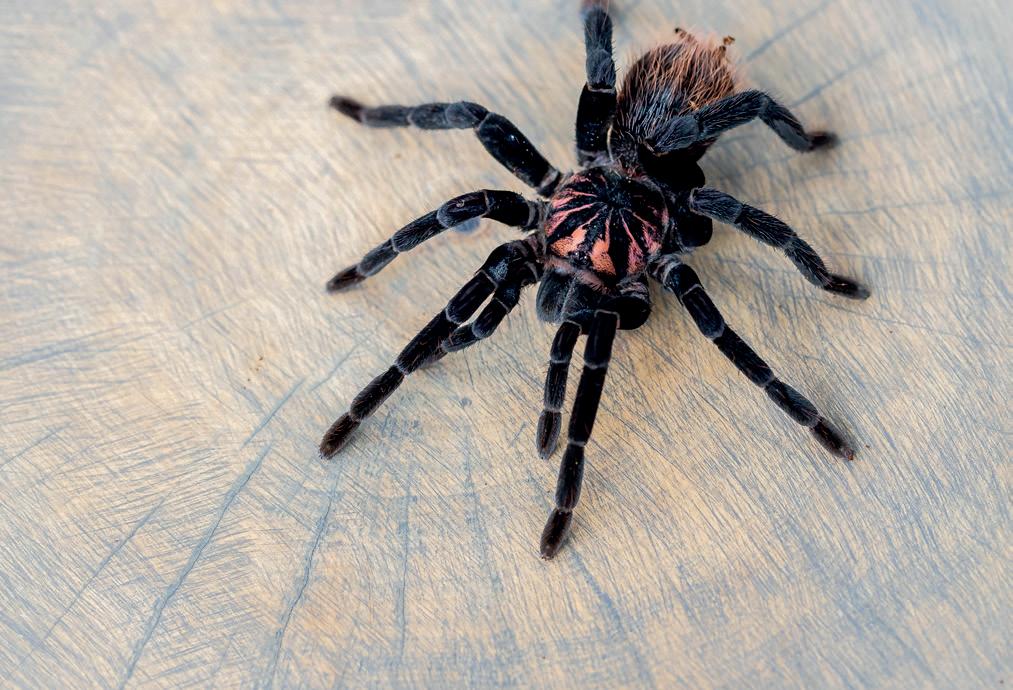
Bird spider
Pamphobeteus
The “bird” or “chicken” spiders of South America are amongst the largest Arachnids in the world. There are currently 18 described species, most of which are very stocky with up to 16cm leg spans. The genus is constantly undergoing taxonomic changes and many formerly Pamphobeteus now belong to the Vitalius genus. Bird/ chicken spiders received their common name from tales of them stealing chicks from farms within the Amazon basin. Their enormous size suggests these stories may have some element of truth.
Dotted humming frog
Chiasmocleis
The dotted humming frog is native to the lowland rainforests of western South America. They are around 2cm in length and inhabit dense layers of leaflitter. Little is known about their activity during dry seasons, but they will typically emerge as wet season approaches and produce up to 400 eggs in a single clutch. This species has been recorded sharing burrows with tarantulas and in some cases, multiple frogs will share the same burrow. Although the dotted humming frog will leave the burrow to hunt, they generally stay within 5cm of the burrow.

Ornate tiger spider
Poecilotheria
The ornate tiger spider is a large species of arboreal tarantula from Sri Lanka. They are an endangered species in the wild but are frequently bred in captivity. Their appeal within the trade can likely be attributed to their vibrant colouration and feisty attitudes. Ornata is the secondlargest of all Poecilotheria and can be identified by its vibrant yellow/orange patches beneath its legs.

11 APRIL 2023
spp.
ornata
immanis
ventrimaculata
The Keeper or the Kept?
Sri Lankan painted frog
Uperodon taprobanicus
Formerly classified under the Kaloula genus like its similarlooking counterpart the “chubby” frog, the Sri-lankan painted frog is an ornate species of fossorial amphibian from South Asia. It is a plump species that can grow up to 7cm in length and is highly adaptable. This species is found in a range of habitats from dry forests to humaninhabited areas up to 1,300m in elevation.
Sri Lankan leaf-nosed gecko
Hemidactylus depressus

The Sri Lankan leaf-nosed gecko is a small species of gecko endemic to Sri Lanka and nearby islands. They are found across the plains and close to human-inhabited areas where they occupy crevices in tree trunks, caves and occasionally, buildings.
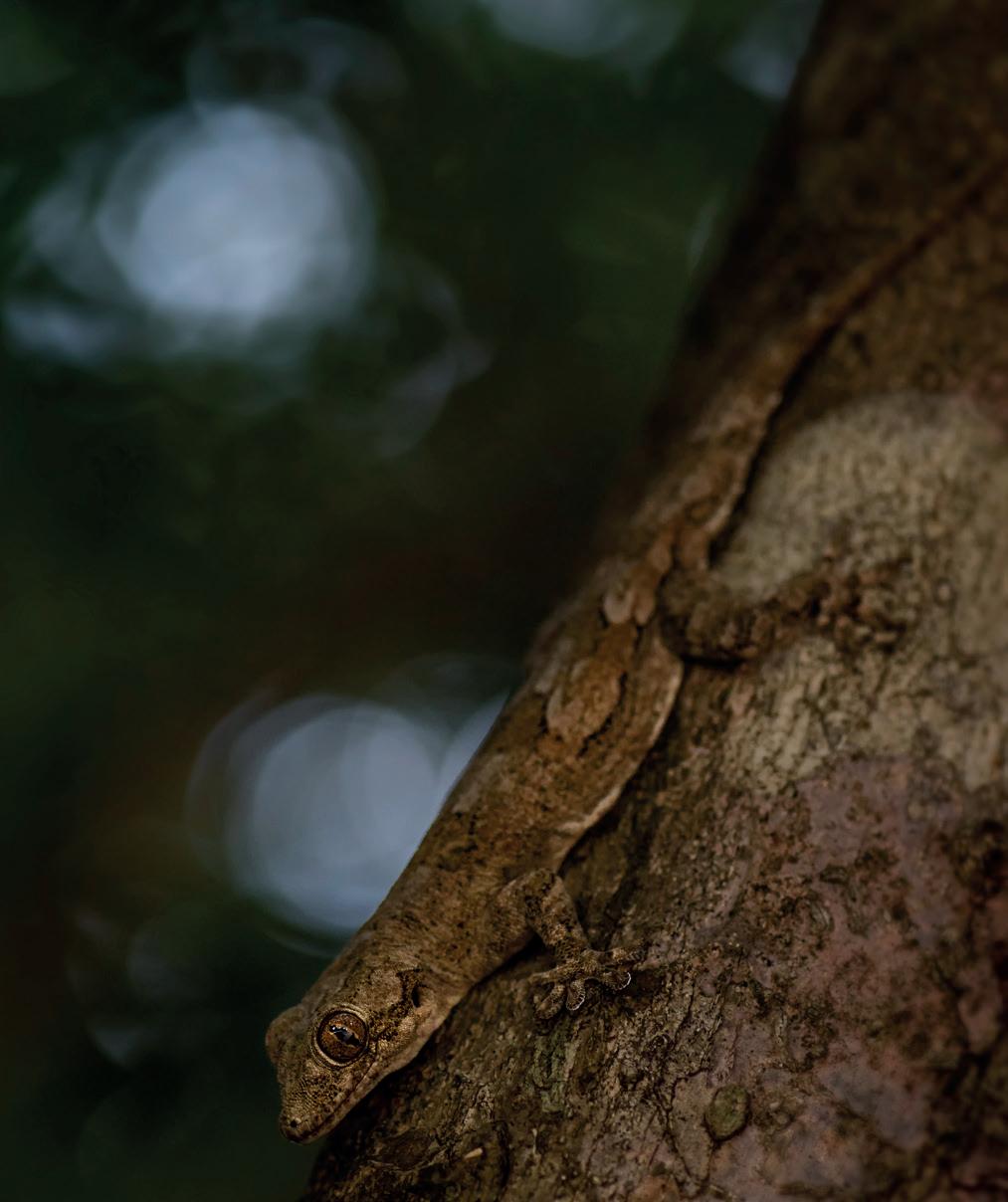
Tungara frog

Engystomops pustulosus
The Tungara frog is a species of Leptodactylid frog from Central America and Mexico. They are a warty species that, for a long time was falsely considered a toad. Like the dotted humming frog, the Tungara frog is a terrestrial species that rarely exceeds 2cm in length and feeds on tiny insects amongst leaflitter. However, this species does not occupy burrows and males will generally congregate around temporary pools of water to call for a mate.
North American tarantulas
Aphonopelma sp.
The Aphonopelma genus is an enormous genus of tarantulas that contains almost all North American species. As of last year, the World Spider Catalogue accepted 59 species although there may be up to 87 species within the genus depending on the source. This means that Aphonopelma makes up almost 10% of the world’s tarantula species.

12 APRIL 2023
The Keeper or the Kept?
Are your tadpoles bloated – maybe with pink or yellow discolouration around the abdomen?
the Tadpole Doctor




Disease in your captive tadpoles?
Have you seen any disease, noticed unusual symptoms, or had unexpected deaths in your tadpoles?
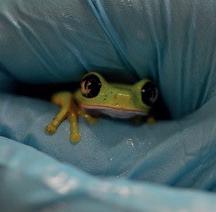


Are your tadpoles bloated – maybe with pink or yellow discolouration around the abdomen?

Have you observed any change in their behaviour, such as: sudden and erratic movements, swimming in circles, loss of equilibrium, sluggishness, floating at the surface or death?
Have you observed any change in their behaviour, such as: sudden and erratic movements, swimming in circles, loss of equilibrium, sluggishness, floating at the surface or death?

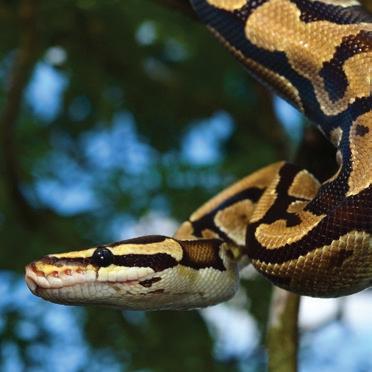


Researchers at the University of Oxford need your help. They are trying to track the spread of a newly identified disease of tadpoles. If you suspect that your tadpoles are showing signs of the disease symptoms mentioned above, please make contact at http://tadpole-doctor.co.uk.

Researchers at the University of Oxford need your help. They are trying to track the spread of a newly identified disease of tadpoles.

If you suspect that your tadpoles are showing signs of the disease symptoms mentioned above, please make contact at http://tadpole-doctor.co.uk


http://tadpole-doctor.co.uk



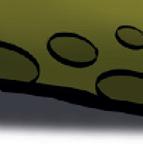










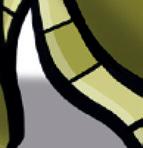









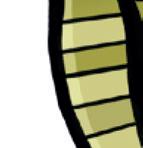
















































13 APRIL 2023
The Royal Society and the University of Oxford bear no responsibility for this project.
tadpole-doctor.co.uk The Royal Society and the University of Oxford bear no responsibility for this project.
SPECIES SPOTLIGHT
The wonderful world of exotic animals
Viper gecko (Hemidactylus imbricatus)
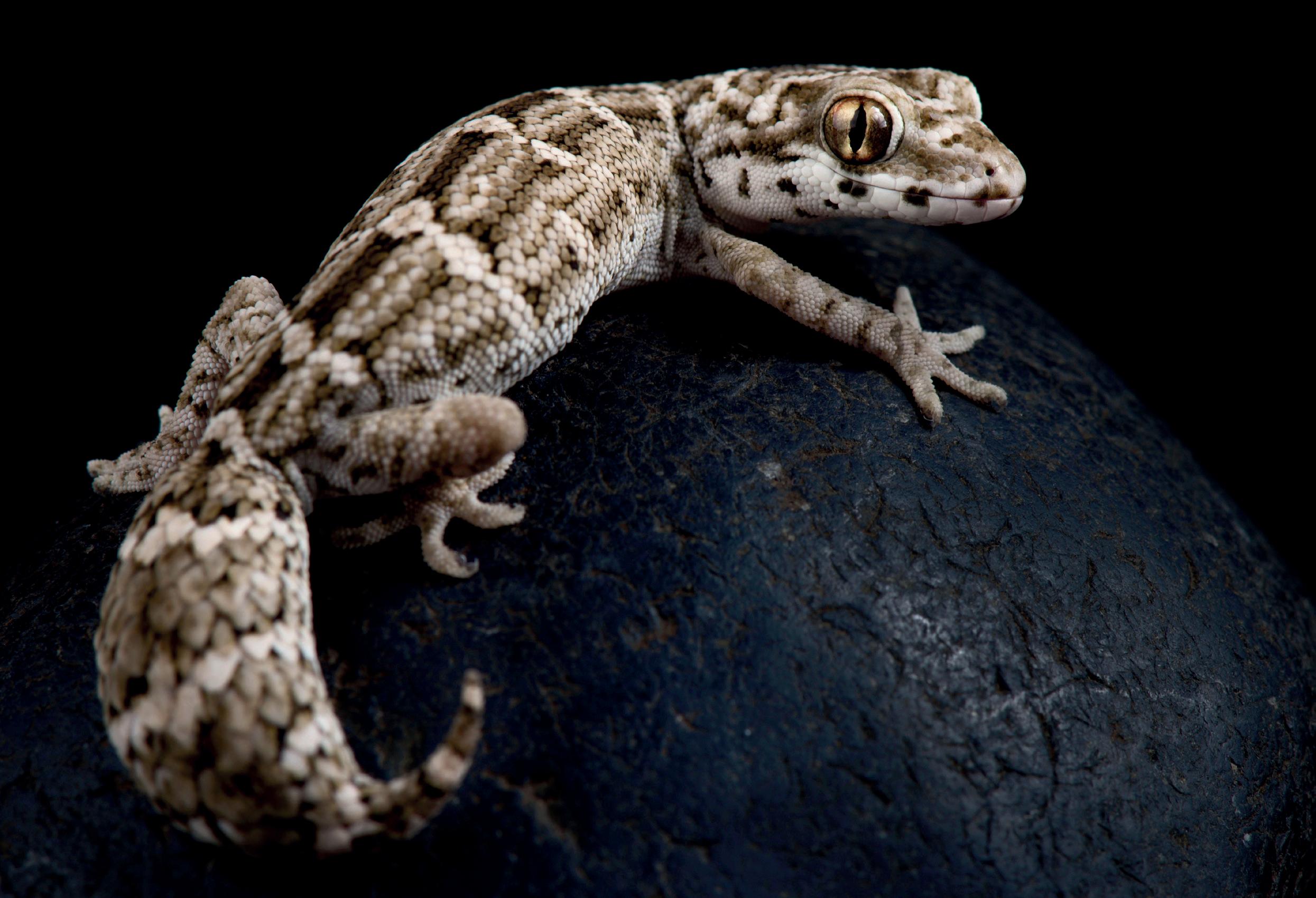
Viper geckos are beautifully patterned geckos from North Pakistan. They inhabit arid locations and rarely exceed eight centimetres in length. Being such tiny animals, they are extremely fragile, so are best suited to enthusiasts looking for an animal to observe, rather than handle. They are the perfect candidate for arid bioactive enclosures. They can be housed communally, will not damage plants easily, are surprisingly active and will breed readily in captivity. These desirable traits may increase the popularity of viper geckos in the coming years as bioactive 'display-style' enclosures become more commonplace in the hobby.
A 60cm X 45cm X 45cm glass terrarium with a hot spot of 35°C is ideal for a trio of animals. Smaller vivaria would be suitable, as would a wooden vivarium. However, the keeper may find it easier to build an arid bioactive with appropriate temperature gradients in a larger, glass vivarium. Humidity should be kept below 50%, but occasional light misting is encouraged and a shallow water bowl should be provided.
Careful consideration should be given to the choice of décor. Lightweight items such as cork bark will reduce the risk of the animals being crushed by an object if they happen to burrow beneath it. Broad-leaved plants such as snake plants, aloe and spider plants make excellent refugia for viper geckos and will hold onto moisture, creating beneficial microclimates. Whilst viper geckos are mostly terrestrial, they will climb and utilise all space within the terrarium.
Cooling the geckos' enclosure by 5-10°C and feeding less often will mimic a winter period and prepare these animals for breeding the following year. The female will lay her eggs in soft sand after a 30-day gestation period. Hatchling viper geckos mature quickly and tend to reach adulthood within 10 months. Until this time, the keeper must be able to source a variety of small-bodied prey such as micro crickets and springtails. Adults can be fed a broad mix of suitably-sized insects preferably at night before the lizards become most active.
APRIL 2023 14
Spotlight
Species
FISH SCIENCE
With Dr David Pool Holiday advice
While holidays are supposed to be an enjoyable time to “switch off”, leaving pets at home can be a daunting prospect for many exotics keepers. Although reptile keepers will most likely require a network of friends or family to support them whilst they’re away, fishkeepers are fortunate in that, providing a few simple rules are followed, their fish can safely be left for a few days, or even a couple of weeks with no adverse effects.
Preparation
Don’t add any new fish or plants for four weeks before your departure date. This could affect the harmony between existing fishes, upset the biological balance between filter and stock level, or result in an outbreak of disease. Symptoms may not appear by the time you pack your cases, but white spot, for example, could spread from a new fish to others in the tank while you are away causing poor health and fish losses. If one fish dies while you are away and the body starts to decompose it will have a major impact on the water quality, with elevated levels of ammonia and nitrite which could have disastrous consequences.
Water Changes
Change 25 – 30% of the water two to three weeks before the departure date and remove any debris that has accumulated in the tank and gravel. At this time, the filter should also be cleaned. Rinsing the filter media in old aquarium water will remove excess debris and ensure that no areas are blocked. Don’t use tap water for this as the chlorines and chloramines will kill helpful filter bacteria and lead to nitrogen cycle problems. Replacement tap water should be the same temperature as that in the aquarium and have been conditioned to remove harmful chlorine/chloramine and other contaminants.
You should also do a second, smaller water change and minor clean-up one week before leaving.
Feeding
It is easy to panic about feeding, leaving last minute instructions for a friend or neighbor or adding more food than usual to build up the fishes’ food reserves. However, fish are able to tolerate long periods without food. This happens naturally in the wild, during the hot dry season for some tropical species, or during the winter in the UK when little food is available.
Algae, plants, insect larvae and snails are all present in most aquaria and will provide emergency rations should they be needed. Fish also have internal reserves of fat
Dr David Pool is the author of 3 books on aquarium and pond keeping as well as over 250 articles on fishkeeping. He has appeared on national radio and television across the world to promote fishkeeping and given talks on the subject throughout the world.

and muscle which they can very effectively utilize so it is unlikely they will starve.
If a friend or neighbor has offered to feed the fish, make sure that they know how much food to give. Too much food can be disastrous for water quality, so one must stress the importance of not overfeeding. If possible, measure out the daily ration into small containers. Asking them to feed the fish once every two days will provide more than enough food to keep your fish healthy. There are also some excellent automatic feeders available which will feed the fish at preset intervals. Once a day is ideal, but you should be feeding less at each meal than normal.
Fish will happily survive for a few days without any food. If you are away for longer than this, you can add holiday foods to provide small amounts of food. ‘Chalk block’ style holiday foods are readily available but have very little food content. Tablet or gel-based alternatives are probably better, but aggressive feeders can sometimes eat everything in the first few days.
Lighting
If you have living plants, lighting is essential. Investing in a timer is advisable to ensure they get the light that they require to remain healthy. If you have no plants, or only artificial ones, it is better to leave the lights off. Leaving the curtains open will ensure that the aquarium gets some light daily which will be appreciated by the fish.
15 APRIL 2023 Fish Science

PRICKLY PETS
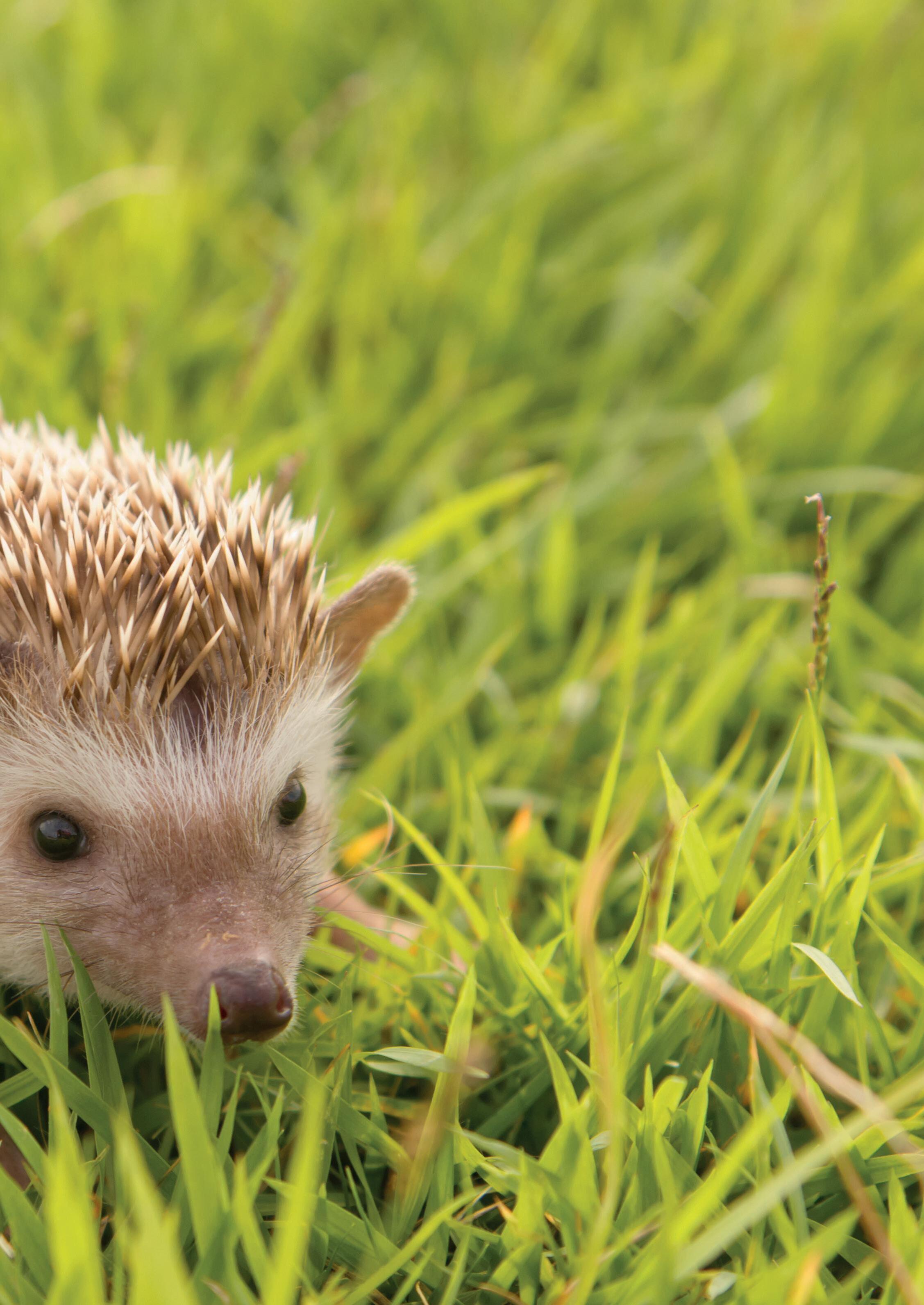 By Rosie Smith.
By Rosie Smith.
African pygmy hedgehogs became popular as exotic pets in the 1980s. Since then, interest in the species has grown alongside knowledge of their care requirements. It is generally agreed that the name “African pygmy hedgehog”, is a term used to describe a domesticated “four-toed hedgehog” (Atelerix albiventris). This is the smallest species within the Atelerix genus. Although, some argue that the African pygmy hedgehogs found in the pet trade today are a hybrid of Atelerix albiventris and Atelerix algerus, however, more research would be needed to prove this theory. The following feature looks at their care and keeping in captivity.
African pygmy hedgehogs became popular as exotic pets in the 1980s. Since then, interest in the species has grown alongside knowledge of their care requirements. It is generally agreed that the name “African pygmy hedgehog”, is a term used to describe a domesticated “four-toed hedgehog” (Atelerix albiventris). This is the smallest species within the Atelerix genus. Although, some argue that the African pygmy hedgehogs found in the pet trade today are a hybrid of Atelerix albiventris and Atelerix algerus, however, more research would be needed to prove this theory.
Following 40 years of domestication, the African pygmy hedgehog can be a friendly companion animal. They are popular in the US states where they are legal, across
Europe, Russia, Asia (mainly Japan and Thailand) and of course, the UK. More domesticated animals typically show fewer defensive behaviours; with handling possible without the hedgehog curling into a defensive ball.
In order of popularity, the African pygmy hedgehog, longeared hedgehog (Hemiechinus auritus), desert hedgehog (Paraechinus aethiopicus) and North African hedgehog (Atelerix algirus) are all kept privately in the UK. The lesser hedgehog tenrec (Echinops telfairi), greater hedgehog tenrec (Setifer setosus) and common tenrec (Tenrec ecaudatus) are also popular amongst hedgehog keepers. Despite not being genetically related to hedgehogs, their care needs are similar.
18 APRIL 2023 Prickly Pets
About the author: Rosie Smith is a teacher of Animal Science and Advanced Practitioner at Nottingham College. She is passionate about the role hedgehogs can play in the Animal Science Education Industry, their role as companion and hobby pets and their ability to engage the public in conservation initiatives. Rosie spent two years on The African Pygmy Hedgehog Club committee, has judged numerous hedgehog shows and has 9 years of experience keeping five species of hedgehog and three tenrec species. Rosie has one of the largest private collections of Long Eared Hedgehogs, as well as African Pygmy Hedgehogs, Desert Hedgehogs and a North African Hedgehog. Rosie has experience volunteering in 2 zoos and working within private animal education before she joined the team at Nottingham College.

Diet
All the African hedgehog species are opportunistic omnivores, with studies showing their diet is comprised of insects, bird eggs, small mammals, lizards, frogs and even plant matter on occasion. This can be simulated reasonably easily in captivity by providing a varied diet with plenty of live foods. As African pygmy hedgehogs are unable to break down cellulose, the feeding of plant matter (including grains and potatoes in commercial food), is not beneficial to the diet of captive hedgehogs. Small bird eggs such as quail and cooked chicken eggs are popular protein options. There is a widespread fear of feeding morio worms to hedgehogs because they can bite, however, all feeder species are enjoyed by hedgehogs and a varied diet is important. Even the use of very active insects, such as roaches and locusts, allows for enriching hunting and exercise behaviours.
Feeding commercial dog food has become popular amongst keepers. The high phosphorus content of meat can be balanced by calcium-supplemented, gut-loaded insects. However, hedgehogs do have small delicate teeth, so pinkie mice or the finely-ground commercial blocks (without visible bone/offal pieces) are more appealing to the hedgehogs.
The African Pygmy Hedgehog Club recommend feeding flaxseed/fish oil supplements 1-2 times a week as well as a mix of high-quality cat biscuits as a primary part of the hedgehog’s diet. Exotic vets prefer to recommend specialist insectivore foods, which can be high in fat. A high-protein diet can be damaging to a hedgehog’s delicate kidneys, and carbohydrates can result in obesity. Therefore, the benefits of feeding a small amount of kibble as part of a balanced and varied diet to maintain teeth and provide a less perishable food option must be carefully balanced by feeding a more natural diet of small whole prey, raw/cooked meats, insects and eggs.

Heating and Seasonality
Both the four-toed and long-eared hedgehogs are nocturnal. UV lighting and basking heat are not often utilised by these species in captivity, as they hide in burrows or hollows to avoid sunlight in the wild. Due to numerous years in captivity, the African pygmy hedgehog now struggles to tolerate temperature drops. If the keeper allows the animals to cool they will likely attempt to hibernate and cannot always be awakened. Therefore, most keepers opt for a 24-27°C constant temperature maintained by a ceramic heat emitter, guarded with a cage
19 APRIL 2023
Black velvet stick insect (Peruphasma schultei)
Prickly Pets
and on a pulse-proportional thermostat. Positioning this at one end of the enclosure allows the hedgehog to select its preferred temperature.
If either species curls into a ball and has a cold stomach or appears to have difficulty waking up at night, the temperature may be too cold. Also, if the animal is laying on its stomach with stretched-out legs (that many people on social media refer to as the “sploot”), it could be an indicator that the animal is overheating. With climate change bringing more unpredictable weather patterns, Some keepers provide cool tiles/chinchilla marbles in the summer to allow their hedgehogs to thermoregulate when the ambient temperature is high.
In the wild, long-eared hedgehogs, live as far East as Mongolia and will often hibernate in the cooler months. Decreasing temperatures to the low 20s for long-eared hedgehogs between November and February can encourage breeding in the spring. During times of cooler temperatures, the hedgehog’s appetite and activity levels will decrease. There is a fine balance between adjusting the temperature to decrease activity and inducing hibernation. The latter can be dangerous and therefore
seasonal fluctuations should be reserved for the more experienced breeder.
Wild four-toed hedgehogs do not breed throughout winter, but their domesticated relatives, the “African pygmy hedgehog” have now adapted to breed all year. Therefore, they should not be exposed to temperature drops.
Exercise and Enrichment
The travelling distance of a wild four-toed hedgehog is around 300-500m per evening. The long-eared species have longer legs and a faster running pace and therefore may travel even further. Hedgehogs in large, naturalistic zoo exhibits can often be observed pacing in circles, as their naturalistic desire to run and forage is still present despite having consumed sufficient food. Therefore, most keepers opt to use a smooth, hole-free bucket wheel as running apparatus. For decades, hedgehog keepers have observed a calmer demeanour from pregnant and nursing mothers that have access to a wheel. These animals are less likely to destroy their litter. The benefits of having access to a “running wheel” have also been recorded in several other species including mice, frogs and even

20 APRIL 2023 Prickly Pets
snails. Although this may not fit in with the traditional “natural aesthetic” of keepers wishing to provide a wildtype habitat, they are a valid option to provide physical exercise and improve the animals’ well-being. Larger hedgehog species such as the desert hedgehog and North African hedgehog also opt to use their wheels as enrichment. However, for these larger animals, a larger wheel should be provided. A desert hedgehog requires a wheel of at least 14-inch diameter, while a North African hedgehog would require a wheel of around 16 – 18-inch diameter to avoid spine curvature issues.
There are many other ways to provide enrichment to pet hedgehogs. Sand baths are popular and allow the animal to roll and exfoliate amongst the sand. Foraging trays can also be used. These are shallow trays with soil, leaves, edible herbs and live prey that provides smell enrichment and prompt natural hunting behaviours.
Tunnels and hides allow hedgehogs to enact natural hiding tendencies. A range of these throughout the enclosure can help the hedgehog to feel safe and allows them to nest in an area with the temperature they feel most comfortable in. Hedgehogs “anoint” by chewing unfamiliar
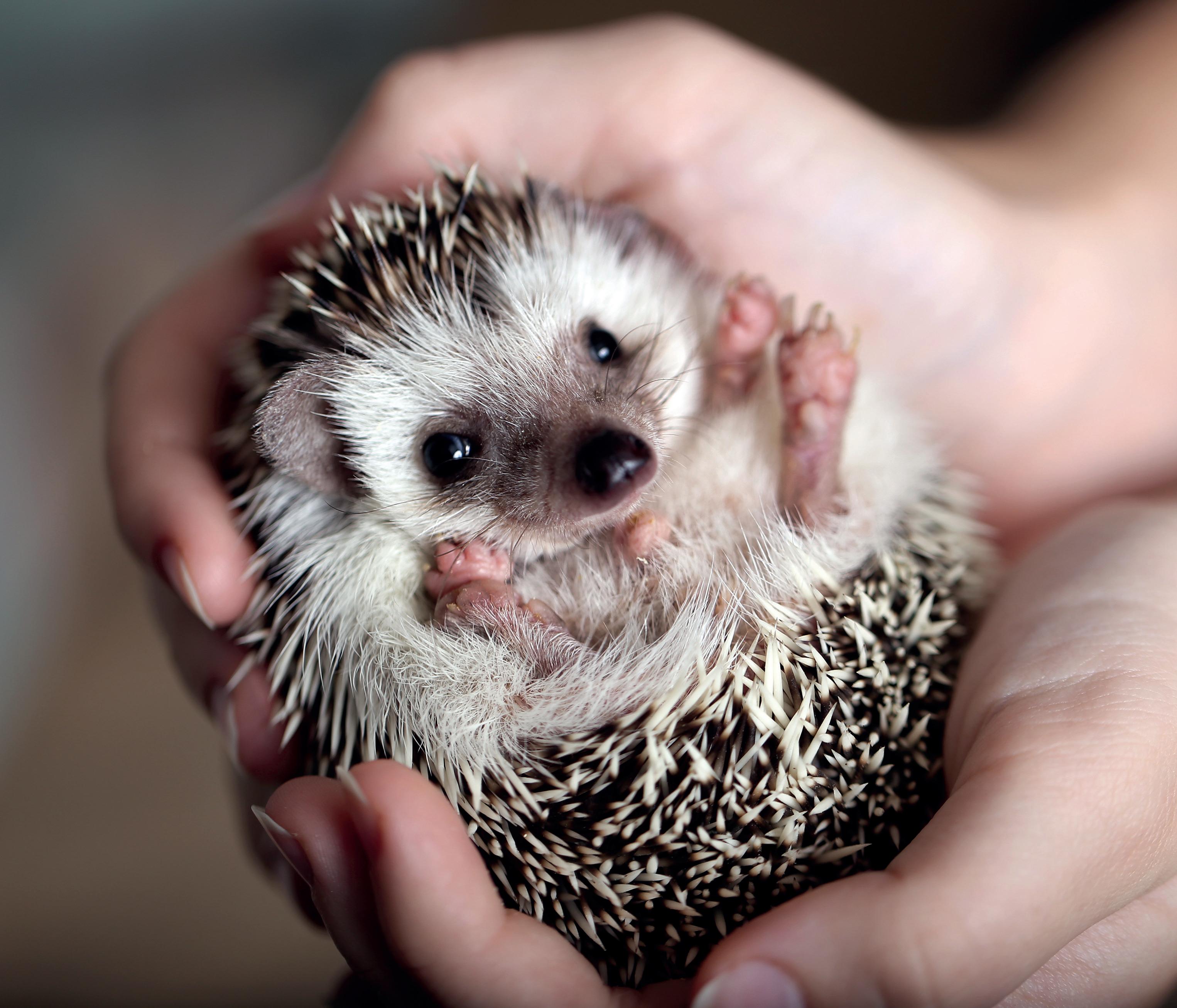
smells, mixing these with spit, and covering themselves with this spit. This can be inconvenient and unhygienic if done with a pinkie or chick, however fresh food items such as strawberries, cooked sweet potato, fresh basil and mint and others can provide smell enrichment despite having little dietary benefit.
Handling and PPE
Handling blankets are the most used form of protection when manoeuvring hedgehogs. Scooping the animal up from underneath to support it and then allowing it to uncurl is the accepted method. Some hedgehogs will even approach their owner when spoken to. This is a good method of calming the animal, as their eyesight is poor. Protective gloves should be avoided as this will prevent the hedgehog from becoming familiar with the keeper’s smell which helps with bonding. Giving a hedgehog a smelly sock to keep is a common way to build up familiarity with its owner and they will chew and anoint with these thanks to their excellent sense of smell. There has even been one example of successful “clicker” training. African pygmy hedgehogs usually ball when startled. Some long-eared hedgehogs will curl,
21 APRIL 2023
however, they have more of a tendency to charge at and bite a perceived threat. This means care must be taken in a walk-in enclosure as they will charge towards footwear. This difference in temperament makes the long-eared hedgehog a less popular companion animal, however, the naturalistic behaviours of "long-ears" make for a better zoological exhibit. Canon Hall’s nocturnal house allows for their long-eared hedgehogs to be observed daily, hunting and foraging. African pygmy and long-eared hedgehogs may be active during the day in captivity due to noise stimuli and its association with food. However, they are generally most active between 11pm and 4am.
Enclosures
Four-toed hedgehogs naturally live in the desert scrub habitat of North and Central Africa but can also be found in dried river valleys and forest edges, even venturing into settled areas. Long-eared hedgehogs also live across Asia and are found as far east as Mongolia. Their natural desert scrub habitat means that naturalistic enclosures are best to replicate these conditions. Despite their tendency to consume a large number of their custodians, bioactive enclosures have been used with success for both species. Zoos, such as Canon Hall Farm, have large, naturalistic enclosures which are easier to maintain without catering for custodians alongside the animal. Hedgehogs tend to defecate and urinate as they run, with their diet making daily cleaning essential. Wheels are popular amongst
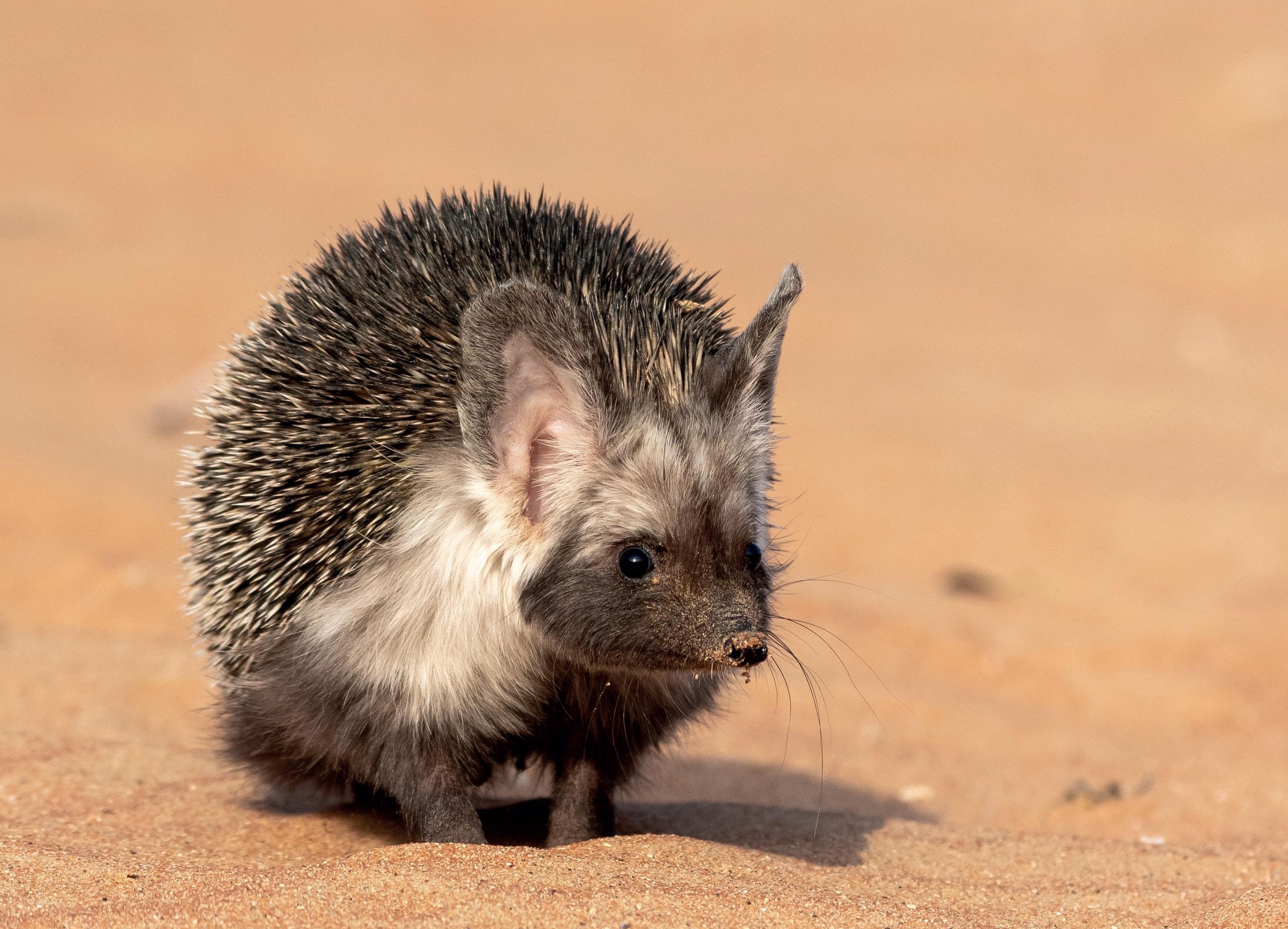
hobby keepers and often a litter tray is placed under the wheel to catch waste and allow for quicker maintenance. Using a sand scoop can also be effective for quick daily cleaning in a naturalistic setup.
A mix of chemical-free topsoil with children’s play sand can be used to create a habitat with numerous digging opportunities. Mosses, branches, dried grasses, small rocks, reptile hides and hollows can be used to create a naturalised and enriched habitat. Care must be taken with humidity as respiratory issues are common in damp environments, whereas dry and dusty substrate can cause eye problems. Deciduous leaves and grasses would naturally be used as nesting materials, however pregnant nesting mothers will often opt for a fleece blanket when given the choice, due to its ability to shield their babies from view and prevent them from escaping the nest. Fleece blankets, liners and sleeping bags are the most popular substrate and bedding in the hobby and can be handy during breeding or quarantine to spot unusual fluid colours or traces of blood. These are also handy to provide shelter and protection for the hedgehog during handling.
The minimum recommended enclosure size is 4ft by 2ft for both species, however, it could be argued that far larger is needed due to their natural tendency to travel over large distances. The most popular choice is a wooden vivarium, as temperatures are easy to maintain.
22 APRIL 2023 Prickly Pets
Socialisation
Keeping female African pygmy hedgehogs together successfully across the hobby is now common, and rarely results in conflict. However, this is not allowing them to express their natural solitary behaviours. As an induced ovulator, males and females only meet to mate and this can result in injury and conflict, therefore most breeders supervise pairings.
Long Eared Hedgehogs are generally aggressive and territorial, meaning they are best housed individually. Mating should be supervised and sadly, biting injuries to the genitals, ears and torso are common. Mating in the common territory can help to reduce territorial behaviours, and a light-coloured, washable floor covering can be used to quickly spot any blood from fighting injuries.
Posh Pedigrees
Several countries have their own “hedgehog clubs/ hedgehog registers” where lineage is tracked for a nominal fee. One of the most common health issues in African pygmy hedgehogs is “wobbly hedgehog syndrome.” It is present in 10% of US hedgehogs but has fewer than 10 reported cases in the UK. It is hereditary and can only be diagnosed with brain dissection, so the diligent tracking of lineages should be encouraged especially considering many hobby breeders will trade internationally. Despite very few cases of “wobbly hedgehog syndrome” being reported in the UK, many of the hedgehogs kept in the UK originate from the US, Poland, the Czech Republic and Thailand. Without lineage records, there is a high likelihood of inbreeding.

There are far more genetic residents from other species of hedgehogs such as the long-eared hedgehog because the main captive populations imported from Egypt were originally kept in Germany and the UK. As the species becomes more popular, individuals are now frequently being exported to the US. As there have been fewer reported cases of genetic issues in this species, fewer keepers are registering and tracking the genetics of their animals. Therefore, inbreeding could cause potential issues in the future. It is vitally important that keepers support studbook initiatives and register their animals wherever possible.
COMMON HEALTH PROBLEMS
• Dry skin is easily treated by increasing healthy fats in the animals' diet (fish oils and flaxseed oils) and malacetic conditioner skin spray can calm this ailment.
• Worms/intestinal parasites can be an issue, especially due to the increasing popularity of whole/raw meats as food items. Vets often recommend treatment with Panacur but faecal smears should be used to diagnose the problem first.
• As captive hedgehogs outlive their wild counterparts, tumours are a significant cause of death. With an 80% malignancy rate reported in the US it is debated whether operating on these, as is common practice, is the correct course of action. Tumours are commonly seen in the mouth and are more difficult to diagnose in the early stages in this location.
• Ear infections can often be caused by mites and will show as waxy ears/tatty-edged ears, a clumsy hedgehog or smell. Ear drops and antibiotics can treat this.
• Respiratory infections due to incorrect humidity or stress are common, with successful treatments including antibiotics and nebulisation. The tendency to use vivariums mean if extra ventilation is not added the humidity in enclosures can become too high. Therefore many owners choose to add extra vents and monitor humidity as well as temperature.
• Natural injuries can cause harm to a pet hedgehog, especially around their delicate eyes, toes and nails. A styptic pencil is a popular item in a hedgehog first aid kit.
• Mites are a common problem, due to the combination of live foods and bedding. These are easily treated if both the animal and enclosure are diligently maintained. Using Demetrius Earth for sand baths, or scattering it throughout the enclosure is a popular solution.

23 APRIL 2023
A Gateway Bug
HERPING THE GLOBE: EXPEDITION MOROCCO
 By Bryan Minne and Laura Ruysseveldt (Herpetological Education & Research Project)
By Bryan Minne and Laura Ruysseveldt (Herpetological Education & Research Project)

Across the world, Morocco is known for its ancient culture, cities booming with colourful scenes and smells of a thousand herbs and spices, great food and beautiful deserts. To us European herpers, Morocco is the ‘Gateway to Africa’. Just a stone’s throw away from Spain, the habitats of Morocco offer a mix of Southern European and African herps. From fire salamanders to cobras, everything can be found in this North African gem.
Since 2015, the H.E.R.P. (Herpetological Education & Research Project) has organised expeditions to Morocco with two simple goals in mind: to observe the maximum number of herp species and to save as many animals as possible from the number one threat within these habitats: cisterns. See, the deserts of Morocco are plagued with a problem that causes thousands of animal deaths each year. They’re riddled with old, broken-down cisterns and wells. In a desert habitat, these structures are true death traps, luring in unsuspecting animals. While the desert can be a dry and scorching-hot place at times, these cisterns offer access to shade, shelter and a sense of security to most animals. Additionally, since many are entirely waterproof, they collect any drop of rain and hold it for several months with ease. Animals looking for an easy drink are coaxed into the wells, never to escape again. In arid desert environments, where the population
densities of certain animals are quite low, these wells pose a significant threat to the survival of some species. For example, during a short wet spell, a single well located in a valley or canyon can attract hundreds of toads, eradicating a huge chunk of the local population in a matter of days. Strangely, these cisterns are man-made desert mirages of a ‘safe, wet oasis’ to these desert-dwelling animals, luring them to their deaths.
Over the course of our many trips to the region, we have mapped out over 100 wells that pose a serious threat to the animals around them. Equipped with climbing gear, four to five vehicles and a strong urge for success we venture off into the desert in search of these wells. During the trip we split up into teams and visit as many cisterns as possible to save the animals trapped inside. With the use of a sturdy climbing ladder and armed with a snake hook,
26 APRIL 2023
Herping The Globe: Expedition Morocco
About the authors: Bryan Minne and Laura Ruysseveldt are the founders of the Herpetological Expedition and Research Project. As well as running workshops and “Repti-School” in their home country of Belgium, the pair also organise expeditions across the world to give enthusiasts the opportunity to observe reptiles and amphibians in the wild.
a few snake bags and a head torch, expedition team members are hoisted down into these man-made caverns. It is not ‘unusual’ to find several snakes, lizards, mammals or toads in a single well! On one trip we rescued over 120 animals from cisterns and wells.


The hustle and bustle of a coastal city - Agadir
We start our journey in Agadir, a coastal city located roughly halfway down the country’s coastline. While this city is a well-known tourist hotspot, we tend
to spend very little time in this area. A quick stop for some spur-thighed tortoises (Testudo graeca) and the first lizards of the trip, but then it is off to the South! During the drive down we can see the habitat change before our very eyes. While the first kilometres give off an ‘Iberian’ vibe, since most of the vegetation found outside of the desert areas in Morocco is quite similar to that of southern Spain, once the deserts start, the vegetation changes with it. Tall trees become sparser, and scrub and bushes become more adapted to sandy substrates. Slithers of green on the horizon indicate the presence of a
freshwater oasis. Other than that, tints and hues of brown, beige, red and orange colour the vista. On the road, we quickly see why Morocco is often called the ‘Gateway to Africa’. Many fully-loaded trucks soar by (with little regard for crossing wildlife) on the one main road, making their way South, down to the rest of Africa. With a little luck, we can see an animal crossing the road. On our many ‘first nights’ we have seen North African hedgehogs (Atelerix algirus), Rüppell's foxes (Vulpes rueppellii) and several snake species. After four hours of driving, we finally reach our headquarters of the
27 APRIL 2023
Herping The Globe: Expedition Morocco
Bryan handling a large Moorish viper (Daboia mauritanica) around Sidi Ifni.
Laura inside a deep, abandoned cistern. These cisterns are rather dangerous to climb into.
trip, the city of Guelmim. From here we’ll explore the South of the country. After settling in it usually doesn’t take too long to find some cool herps around the rooms. The lodge we use is prime habitat for the Berber toad (Sclerophrys mauritanica), the Sahara frog (Pelophylax saharicus), the Moorish wall gecko (Tarentola mauritanica) and even an occasional African house snake (Boaedon fuliginosus). After some food we start discussing our game plan with the team. Depending on environmental conditions we set a plan for the upcoming week.
Arriving in the desert oasis - Guelmim
Our first destination is usually the high-density regions around the city of Guelmim. We set course to some beautiful habitats that harbour old riverbeds, ancient ruins and (you’ve guessed it) many old cisterns. Our target species for this area are the Mediterranean chameleon (Chamaeleo chamaeleon), viperine snake (Natrix maura), many-scaled cylindrical skink (Chalcides polylepis), Bosc's fringe-toed lizard (Acanthodactylus boskianus), Montpellier snake (Malpolon monspessulanus), Morocco lizard-fingered gecko (Saurodactylus brosseti), Bibron's agama (Agama bibronii) and the epic, beautiful black ‘Moroccan’ cobras (Naja haje). While these large elapids are classified

as Egyptian cobras, the Moroccan locality is often much darker than their Egyptian cousins. Juveniles are spectacularly coloured with a golden base coloration and a dark reticulated pattern on the body and solid black heads and necks. Specimens that are undergoing the ontogenetic colour change are often speckled brown/ black, an intermediate pallet slowly shifting to solid black adult coloration. Absolutely gorgeous animals and, dare I say, the number one target for many herpers venturing to Morocco. We know of several farms where cobras are relatively common and the cisterns around these farms generally provide a specimen or two! While herping these areas we have often come across the local ‘aissaoui’. These traditional snake catchers have been tracking and catching snakes for generations. They track snakes by the traces they leave in the sand and the marks they leave around the burrows they use for resting and hunting. This ancient practice dates back over 500 years to the religious order of the Aissawas. The Aissawas brotherhood were considered to be healers and naturalists with a vast source of knowledge about fauna and flora. They were relied upon by the local communities to heal snake bites, catch animals from houses and farms and create medicines and ointments made from animals and plants. The Aissawas often used snakes to demonstrate their power over animals, by making it look like

they controlled their movements and behaviours, giving rise to the ‘snake charmers’ we see today. While most ‘snake charmers’ we see operating in the cities nowadays are doing it as a tourist attraction, the ‘true’ snakehunting aissaouis still exist, far away from the hustle and bustle of the cities, living an often lonely and secluded life in the desert. The local communities still consider them to be healers and true beast tamers to this day, often referred to as “chosen by God.”
Scientific research has shown that there are about 80-90 snake charmers in Morocco that collectively exploit about 3,500 snakes per year. Most animals live very short lives due to being maltreated and poorly fed. The most exploited species of all is hands-down the Egyptian cobra. While we do not condone this practice, it is important to understand its deep-rooted cultural and traditional origin. Additionally, it is interesting and baffling to see how skilled these men are at tracking down snakes. They are very eager to show their skills and teach you how to identify and follow snake tracks.
At night we start cruising! A lot of roads around Guelmim are excellent for road cruising, especially the ones off the main road or further away from town. Top targets are the Mograbin diadem snake (Spalerosophis dolichospilus), Northern elegant gecko (Stenodactylus mauritanicus), horseshoe whip snake (Hemorrhois hippocrepis), helmethead
28 APRIL 2023
An extraordinarily colored male Moroccan uromastyx (Uromastyx nigriventris) ©Laura Ruysseveldt
©Laura Ruysseveldt
gecko (Tarentola chazaliae), western false smooth snake (Macroprotodon brevis) and of course, the puff adder (Bitis arietans). When considering all species we can see on our expeditions, many rank the puff adder quite high in their target list! While fairly common in sub-Saharan Africa, the puff adder is not always easy to find. Morocco has what is called a ‘relict population’ of puff adders. This is a restricted population that got cut off from the larger population, which was previously connected in an earlier time, most likely before the formation of the Sahara Desert. This large, stout viper is a force to be reckoned with! We always tell our members to keep a safe distance from bushes when herping, just to avoid getting surprised by puff adders laying in ambush. This warning is often only remembered for a short time… until they see an adult animal lifting itself off the ground entirely while striking, covering more than its entire body length in the process! Moroccan puff adders are strikingly contrasting in coloration with beige or greyish tints. Beautiful animals and always fun to come across! During our road cruising adventures around Guelmim we often see more Rüppell's foxes (Vulpes rueppellii), lesser jerboas (Jaculus jaculus), wildcats (Felis silvestris) and the ever-charming fat sand rats (Psammomys obesus).
Out of the frying pan - Assa
On to the next location! One of the most notorious locations in southern Morocco must be Assa. This place is referred to as one of the hottest spots in Morocco. On our first ride through Assa in 2015 our thermometer showed a whopping 56°C! Around this region we have some exciting spots for many cool species. On our way into Assa we pass by some excellent habitat for the Moroccan uromastyx (Uromastyx nigriventris). These large lizards can be seen basking on the side of the roads on top of rocks. The variety in colors of these lizards is insane! One can observe green, orange, brown, yellow or even multicolored specimens within a few minutes time. Alongside
them, you can also see Böhme’s agamas (Trapelus boehmei) and Bibron's agamas (Agama bibronii) basking on the rock piles. Getting into the city is often a hassle. In Morocco almost every large slab of desert that is anywhere near a border is dubbed a ‘military zone’. The deserts and canyons around Assa are no different. When a group of 15 tourists roll up in rental vehicles into the town’s control points, the military officers aren’t sure what to do. Luckily, our many years of experience in the country make these types of stops swift and easy! After grabbing lunch in the town we explore areas deeper into the desert, further away from the town in search of some other epic lizards. One of the top targets that have eluded us for years is the incredible desert monitor (Varanus griseus). While we have seen this species in Iran before, we have never been able to find one in Morocco (even though we’re looking for them in the best possible spots). After checking the most notorious cisterns in the valleys for monitors, we head on to a stellar cruising road to wait out nightfall. When the sun has finally set, we drive down to a valley that is known for its density in herps! Here we often get Oudri's fanfooted geckos (Ptyodactylus oudrii), Algerian whip snakes (Hemorrhois algirus) and one of the rarest Moroccan snakes, the white-bellied carpet viper (Echis leucogaster). These are very beautiful, but deadly little snakes and a top target for many a herper!
Since the drive back to Guelmim can be quite long, we usually decide to camp out in the desert. Luckily we know an incredible spot to spend the night at and a few nomads that live nearby and can set up camp for us, as well as prepare a delicious meal, even if it is close to midnight! After a short night, we wake up in the middle of a beautiful area with desert as far as the eye can see. This incredible area is covered in loose sand and many shrubs. The early morning light reveals hundreds of thousands of tracks in the sand, ranging from darkling beetles (Pimelia grandis), scorpions (Hottentotta gentili), small-spotted lizards (Mesalina guttulata), crowned leafnose snakes

29 APRIL 2023
Local aissaoui tracking snakes. He is using a piece of mirror to reflect sunlight in a burrow, a cheap alternative to a flashlight. ©Laura Ruysseveldt
(Lytorhynchus diadema) and the notorious desert horned vipers (Cerastes cerastes). Finding these beautiful vipers by following their tracks in the sand is an incredible experience. From identifying the track, estimating its age and determining the direction in which the snake was travelling to successfully tracking it to the location where the animal is hiding is just an unforgettable experience. We have been herping all over the world and this one activity, still, is one of our all-time favourite things to do! On this location we have also seen sand cats (Felis margarita) and fennec foxes (Vulpes zerda) before.

A day by the beach - Sidi Ifni
One of our all-time favourite spots to visit during our expedition is the coastal area of Sidi Ifni. Since it is a coastal town the temperature and humidity here are way different than more inland towards Guelmim. You’ll often get greeted by a thick layer of mist in these parts, making sure you’ll have a much cooler day. Around Sidi Ifni there are literally hundreds of farmlands that host a wide variety of species and a whole bunch of abandoned (and in use) wells. It is not uncommon to find puff adders, cobras, and many other snake species in these. One local species has eluded us over the years as well. The Sahel egg eater (Dasypeltis sahelensis) is an egg-eating snake that is considered to be common in the opuntia farms surrounding Sidi Ifni. Many of our herper friends and colleagues in herpetology have found egg-eaters in these cisterns before. Unfortunately for us, we have
never been lucky! Still, Sidi Ifni is a wonderful place that has a huge number of cisterns and wells to explore. On the outskirts of Sidi Ifni one can find the Mediterranean tree frog (Hyla meridionalis), Algerian skink (Eumeces algeriensis) and even some Moorish vipers (Daboia mauritanica) if you’re lucky! More to the coastline you can find some dune specialists closer to the beach. If you see weird wiggly tracks in the sand you’re looking at the activity of a Duméril's wedge-snouted skink (Chalcides sphenopsiformis). While fairly common in these coastal dunes, getting one out of the sand can be quite the challenge! The trick? Find a track that seemingly stops somewhere and start digging ferociously! Most of the time a quick scoop with the side of the foot can unveil whether or not a skink is hiding at the end of the track. It usually takes a track or two (read ‘a few dozen’) to actually find a skink. When you do, you see a weird squiggle diving straight back under the sand you better be quick!
East, West, South’s best - Tan-Tan
The main road to Tan-Tan is riddled with cisterns and wells. It takes all vehicles close to the entire day to cover them all. On one expedition we rescued over 30 snakes in a single drive on this route! Among them cobras, horned vipers, Moorish vipers, horseshoe whip snakes, diadem snakes, Montpellier snakes and by far the most common here are the false cobras (Ragherhis moilensis) and the Schokari sand racer (Psammophis schokari). The only problem? The road itself… It is literally the only road going from North
30 APRIL 2023
An adult female desert horned vipers (Cerastes cerastes). ©Laura Ruysseveldt
to South and that means a LOT of traffic during both the day and the night! Stopping for a snake crossing the road can be one of the most dangerous things you can do in Morocco. We have seen quite a few snakes get squished in front of our very eyes on this road, including a large, adult female Egyptian cobra. Anyway, taking it slow is paramount and we must make sure we check every single cistern and well in sight. Making sure that hand protection is worn while opening the wells is rather important! In every well or cistern there are at least one or two black fat-tail scorpions (Androctonus mauritanicus) lurking about, especially on the underside of the lids.
If we make it down in time, we might opt for a drive further South. After the city of Tan-Tan there is a road leading all the way to the border with Western Sahara. Just above that border is a beautiful area called Khenifiss National Park, a coastal dune area full of wildlife. Walking over the dunes reveals the diversity of fauna within this park through the tracks they leave in the sand. Closer to the water’s edge it is not uncommon to see greater flamingos (Phoenicopterus roseus) skimming for food. While this park is a bit of a way off and accommodations there are suboptimal (to say it lightly) it offers some excellent habitat for another incredible herp target species, the Sahara sand viper (Cerastes vipera). The drive is long, but if the conditions are right it might be worth the trouble! Depending on our time we decide whether to stay the night or not, but whatever we do, we make sure that the way back up is done during the night. We have often cruised through the night from our trip to
HERP Morocco

Herping in Morocco is truly a wonderful and memorable experience. The country is vast, has a rugged vibe, is fairly safe and harbours a beautiful variety of fauna and flora. After a week of wading through the deserts of Morocco with us, you’ll find dust and sand in strange places. BUT… you’ll have stories to tell and pictures to go through for months to come. If you want to experience the best herping in Morocco all while saving and helping local populations of herps, join us on one of our next H.E.R.P. Expeditions!

31 APRIL 2023
Tan-Tan back North to make it back to our base camp in the early hours of the day.
A gorgeous little female Sahara sand viper (Cerastes vipera) found on the move in the dunes. ©Laura Ruysseveldt
AMPHIBIANS WITH TWO SIDES
By Leandro Bergmann, Responsible Herpetoculture Expert (Germany)

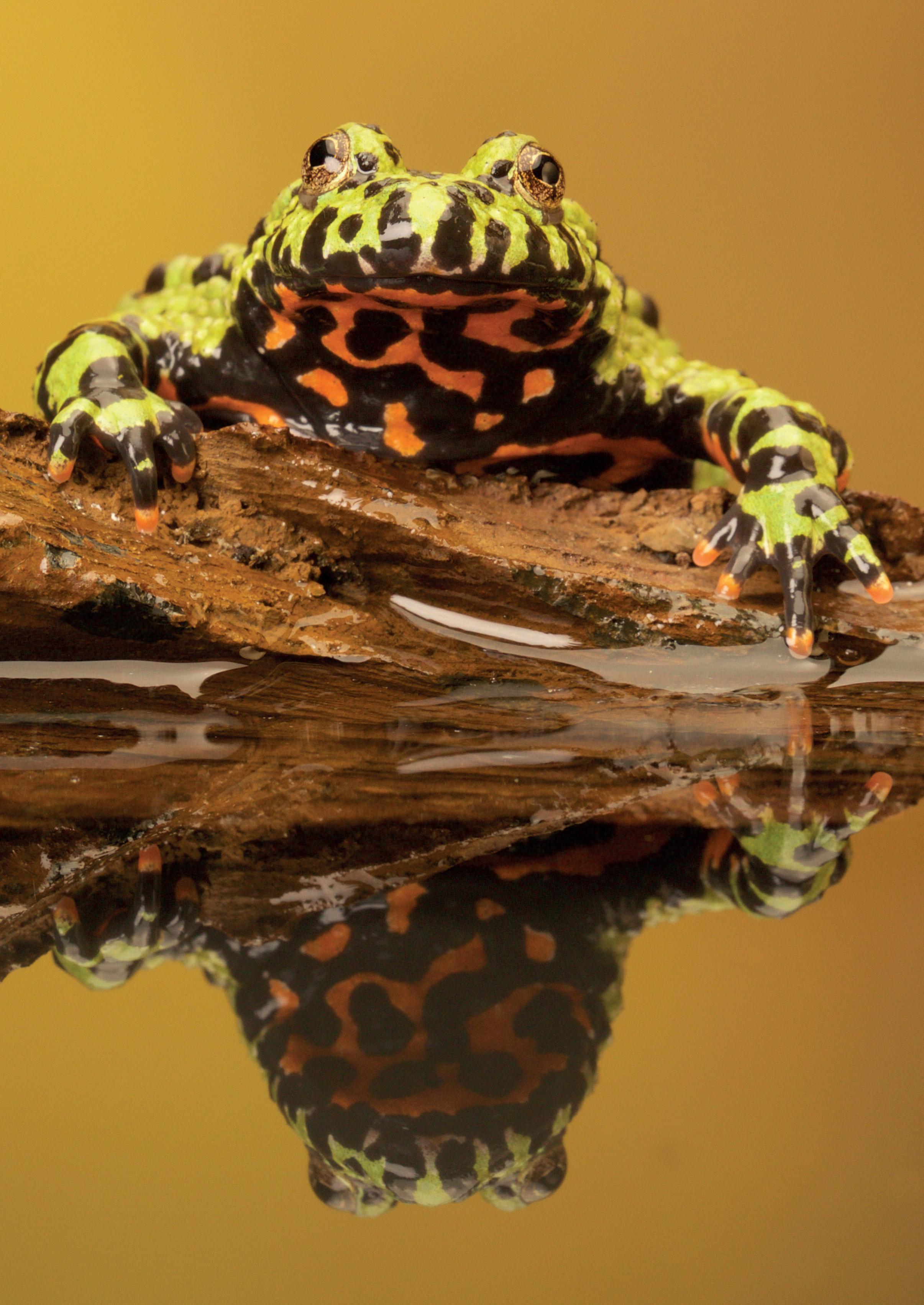 With Two Sides
With Two Sides
Fire-bellied toads are a very diverse group of amphibians. Some species are strikingly coloured, while others are very well camouflaged. The Chinese fire-bellied toad (Bombina orientalis) is popular across the world because it is easy to keep, attractively coloured and new colour morphs are being discovered all the time. Other species (and subspecies) are still rather unknown in herpetoculture but may become more popular in the near future. Fire-bellied toads are interesting and active creatures that make excellent pets. I have been keeping and breeding fire-bellied toads for seven years. In the following feature, I would like to briefly introduce the species and discuss keeping and breeding.
Fire-bellied toads grow to 4-9cm, are semi-aquatic (living half in the water) and have heart-shaped pupils. They are considered primitive anurans. All fire-bellied toads have striking abdominal colouration. To some extent, fire-bellied toads have two sides. One gives the best camouflage, while the other can scare off enemies. On their underside, black spots are found on a red, orange or yellow background. These colours serve as a warning and are meant to signal to the enemy: "Attention! I am poisonous!” If danger threatens, the fire-bellied toads fall into the so-called "Unkenreflex". They bend their backs into a hollow cross and bend their limbs upwards so that the ventral side is presented. This reflex serves as a deterrent and has also been observed in other amphibians. Unlike other frogs, fire-bellied toads produce inspiratory calls, i.e. when breathing in.
Classification
Fire-bellied toads represent a separate, rather concise genus: Bombina. Together with the Barbour frogs they form the family Bombinatoridae. The species or subspecies status of some taxa of the genus Bombina is still under discussion. Depending on the author, up to eight species and a few subspecies are recognised. This is also due to the species concept preferred by the respective researcher. The genus is divided into two subgenera: The small-sized species (Bombina bombina, Bombina orientalis, Bombina pachypus and Bombina variegata) are listed as the subgenus Bombina, while the remaining large-sized species (Bombina maxima, Bombina microdeladigitora, Bombina fortinuptialis and Bombina lichuanensis) form the subgenus Grobina.
34 APRIL 2023
Amphibians
Fire-bellied toads inhabit the Asian and European continents. European species include the European fire-bellied toad (Bombina bombina), which is native to East Germany and whose range extends to the Ural Mountains in West Russia and the Yellow-bellied Toad (Bombina variegata variegata) which is also found in Germany. This species has a western and an eastern lineage. The distribution of the western nominate form stretches from Central Europe to the northern Balkan region, while the eastern nominate form inhabits the Carpathian regions. Two subspecies of the yellow-bellied toad have been described: The Greek Yellow-bellied Toad (Bombina variegata scabra) inhabits the southern Balkan region, while the Dalmatian Yellow-bellied Toad (Bombina
About the author: Leandro Bergmann is a hobbyist breeder from Germany. He maintains a collection of Bombina bombina, B. maxima, B. orientalis, B. pachypus, Bombina. v. variegata, Bombina v. scabra and Bombina v. kolombatovici. He has written articles for herpetoculture publications and has interests in native, German wildlife. More information on Leandro’s breeding projects can be found on his Instagram page @bombina.world
variegata kolombatovici) is found in Dalmatia. The species status of this subspecies is disputed. The last European species is the Italian Yellow-bellied Toad (Bombina pachypus), which is native to southern Italy.
The Asian continent, on the other hand, is inhabited by the Chinese fire-bellied toad (Bombina orientalis), which occurs in China, Japan, Korea and Russia. The largewebbed bell toad (Bombina maxima) inhabits China and the small-webbed bell toad (Bombina microdeladigitora) occurs in Vietnam. There are also the Lichuan fire-bellied toad (Bombina lichuanensis) and the Guangxi fire-bellied toad (Bombina fortinuptialis). Although, the species status of these two is also controversial.
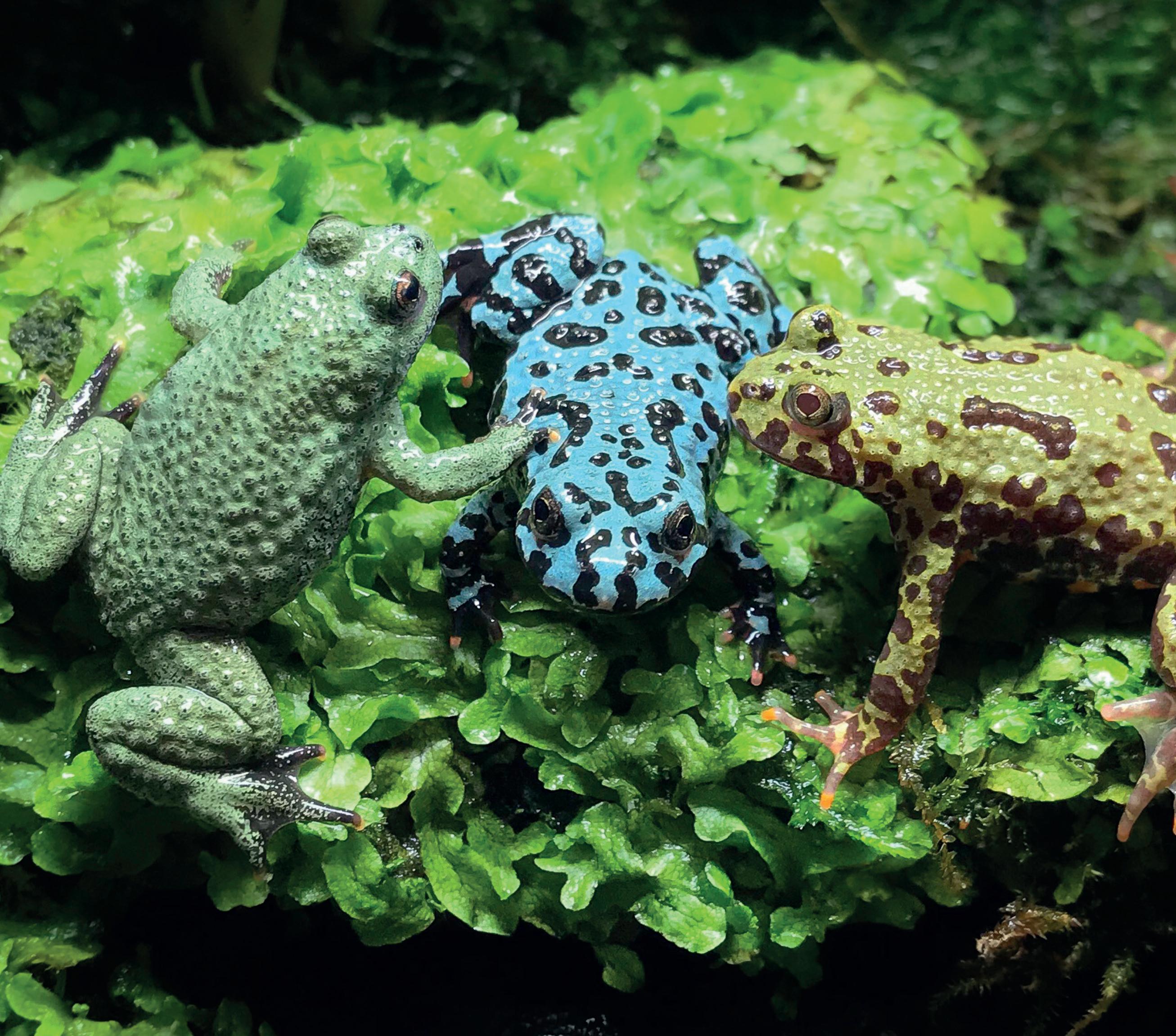
35 APRIL 2023
B. orientalis morphs ©M. Harzdorf
Amphibians With Two Sides
Creating the perfect setup
Keeping fire-bellied toads is quite straightforward, especially for Bombina orientalis and Bombina variegata Both are suitable for beginners. As a rule of thumb, the tank size for up to 6 adults should be at least 60 × 30 × 30 cm. 1/3 of the area should be taken up by the terrestrial part, while 2/3 should be reserved for the aquatic area. The water depth may be 5cm to 15cm with adequate planting. The two areas can be separated from each other by separating glass, or large flat stones or cork bark can be used for the “land” area. The terrestrial part should offer some hiding places. This can be in the form of extensive planting, caves or crevices in the furnishings. I have always focused on a design that is as close to nature as possible. The most useful plants are ferns, ficus and various dragon trees. The floor can be divided into several levels: A layer of expanded clay at the bottom to catch the water, gravel on top and terrarium soil as the top layer. You can also use moss (that should be replaced from time to time). A small filter pump must be installed in the water area, but the water should still be changed two to four times a month. The humidity should be between 60% and 100%. The water usually has a constant temperature of about 18°C.
In summer, I measure average temperatures of around 18°C to 30°C in my indoor facilities. I use UVB lights, which are especially important for the Italian yellow-bellied toad (Bombina pachypus). For this species, I also use a 15-watt "Exo Terra Daytime Heat Lamp". This is because Bombina pachypus is from the south of Italy below the Po Valley. It is very warm there and pachypus are more sensitive and require more warmth. The lamp is only switched on for a few hours a week. However, it is very important that they are kept in partial shade and that you are always present while the lamps are on. Otherwise, the containers can overheat too quickly. I keep Bombina maxima a bit colder, because they don’t like it when it is too hot.
How to feed fire-bellied toads
Nutrition is a decisive factor for the health of the animals. The feeding insects must be dusted with a conventional vitamin-mineral supplement every second or third feeding. If this is omitted or neglected, rachitic deficiency symptoms can occur, especially in young animals, which
puny growth. In addition to this aspect, I believe that a varied food supply is an essential component of speciesappropriate husbandry. Fire-bellied toads are voracious amphibians that eat anything that fits into their mouths. While young animals must be fed daily, adult fire-bellied toads only get food every two to three days. I release the live foods into the terrarium so the hunting instinct is maintained. This provides special insight into the behaviour of the animals. Prey capture follows appetence behaviour: directed appetence, taxis and final action. To illustrate this, let's take a realistic scenario: a fire-bellied toad is sitting on a rock and resting. A small cricket, which does not notice the fire-bellied toad, approaches the rock. The hunter sees its prey and focuses all its attention on it. With careful movements, the fire-bellied toad now tries to gain an appropriate distance. When the distance between hunter and prey is only a few centimetres, it gets ready to jump and then, at the right moment, grabs the insect by one end and devours it piece by piece. I have already offered them all kinds of food. Crickets (Acheta domesticus) in various sizes are particularly common in our pet shops. Mealworms/flour beetles (Tenebrio molitor) are also often found in the assortment. However, the latter should only be offered rarely, as they are very fatty and fire-bellied toads tend to be overweight. In the terrarium, you can also offer crickets (Gryllidae), milkweed bugs (Oncopeltus fasciatus), earthworms (Lumbricidiae) and even flies (Musca). It is interesting that in a group of toads of the same species, some animals accept food that their conspecifics spurn. I have already observed this in the compost worm (Eisenia) and isopods (Isopoda) as well as in nudibranchs (Nudibranchia). This suggests that fire-bellied toads have different preferences of their sense of taste and thus also likes and dislikes. Adult fire-bellied toads can survive one to two weeks without food, but young animals need more regular feeding. Fire-bellied toads can reach a proud age of 30 years if well cared for.
How to hibernate your fire-bellied toads
Hibernation is important for breeding purposes. Before starting hibernation, the animals must fast for 2 weeks. Some incubators can be used as refrigerators for breeding purposes. These are inexpensive and available from

36 APRIL 2023
B. orientalis terrarium at a zoo
various suppliers. My fire-bellied toads spend the winter in small fauna boxes lined with moss and pieces of foam, as these already have a sufficient number of air holes in the lid. These boxes are transferred to the incubator at 15°C. Over a few days, gradually lower the temperature to between 3°C and 6°C. The temperature should not fall below 3°C, but also not exceed 10°C, otherwise, the toads may be in danger. The condition of the animals and the humidity should be checked at least weekly. During hibernation, the animals go into a state of rigidity. The circulation is considerably reduced and the fire-bellied toads appear sleepy to passive. The length of hibernation should be at least six weeks, to a maximum of 12 weeks. With the end of hibernation, the temperatures are gradually raised again and the animals slowly awaken from their state. At first, the fire-bellied toads seem a little dazed, but this soon disappears and they quickly return to being active amphibians.
Sexing fire-bellied toads
Fire-bellied toads show a clear sexual dimorphism. This makes males very easy to distinguish from females, provided both sexes are present and they are adult toads. The determination after hibernation is particularly precise: females have already formed their first spawn and generally appear somewhat plumper. Their skin is also smoother. Males, on the other hand, have a more athletic figure: they are usually a little larger than the females and have strong horny warts and strongly pronounced webbed hind feet. The clearest distinguishing feature,
however, is the male's rutting calluses on the inside of the upper arms. The grey-to-black pads already appear during hibernation and serve as a secure grip during mating.
How to breed fire-bellied toads
After hibernation, the males get into the mood very quickly. With a melody of calls, they herald the beginning of the mating season. They now swim around in the enclosures and clasp everything that gets in their way. If other males or females unwilling to spawn are clasped, they react with calls for release. The animals are particularly active after rain showers or thunderstorms. Since fire-bellied toads inhabit ephemeral waters in nature, these are filled with fresh water after downpours - ideal for offspring! In the terrarium, you can help by spraying or by doing frequent and extensive cool water changes. Now, the animals are unstoppable. The males swim around and demarcate their calling territory by vigorously striking with their hind legs. Females are clasped directly. When they are ready to spawn, they tolerate the clasping and amplexus inguinalis occurs. This is because fire-bellied toads, unlike other toads, cling to the lumbar region. The pair now stay together until spawning which can take a while. It can take several days or even a week until the spawning process takes place. Spawning usually happens at night or dusk and takes several hours. Beforehand, the males will vibrate and wiggle. The female fidgets with her hind legs and rubs them against her partner's pubic
symphysis to let him know that she is about to lay eggs. The mate then arches her back and brings her cloaca as close as possible to the female's cloaca to inseminate the emerging eggs directly on the outside. These eggs are attached in many small clumps to structures in the water, such as plants and stones, with gyrating movements. The pair separates again after spawning. Fire-bellied toads spawn several times a year, which is uncommon amongst other toads.
Raising offspring correctly
It makes sense to place copulating pairs in suitable containers for rearing before spawning. This saves you the tedious task of picking up all the eggs. The quantity of eggs depends strongly on the age, the female, the current condition and other factors. Literature values are usually between 20 and 100 eggs per spawning cycle. The number of eggs decreases each time within a season. If the toads have spawned in the terrarium, the spawn should be left in situ for at least one day to achieve the highest possible fertilisation rate. Then you can transfer the eggs to the appropriate containers. I use plastic tubs measuring 60 × 40 × 40 cm. You should plan two litres of water per larva to ensure the healthiest possible rearing. In addition, the young larvae will then be stronger and larger and avoids overcrowding. I keep the water temperature at 15 - 18°C, as development takes longer at lower temperatures, but larger and stronger froglets will emerge later. Temperatures that are too high produce the smallest "mini fire-bellied toads", which are very difficult to care for. Depending
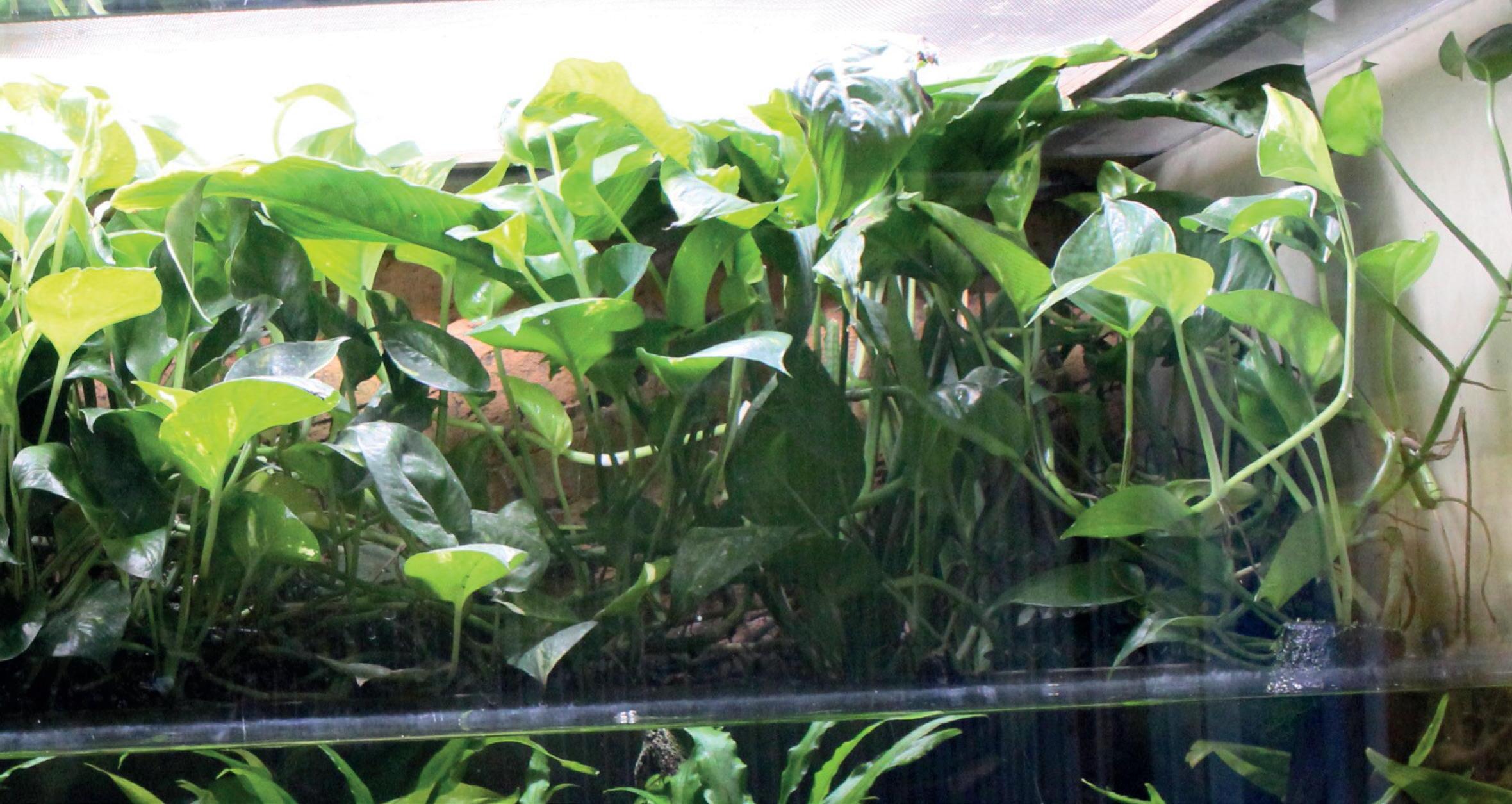
37 APRIL 2023
on the temperature, the larvae hatch after 3-10 days. The development process in the egg can be observed very well: First, two poles are visible, a black one and a white one, with the black one pointing upwards to receive light. Over time, the white turns black. A comma emerges from the sphere and soon the gills and eyes of the embryo are visible. After hatching, the approx. 0.5 cm large tadpoles reabsorb their yolk supply. Soon they are swimming around and attaching themselves to plants and walls with their adhesive apparatus. At this size, they consume the smallest algae. A few days later they should be fed for the first time. You can offer them all kinds of green food, such as dandelion, lettuce, algae, clover, daisies, nettles and old leaves, as long as they are not toxic. Before feeding them, you should freeze them properly so that the plants become softer and are easier for the tadpoles to digest. You can also feed fish food flakes.
A layer of gravel can be used as substrate in the tadpole aquarium. The water level should be about 20cm. The rearing takes some time and a partial water change is required every day because a lot of mulm is produced. It is advisable to give small portions of food several times a day, which are eaten quickly, rather than feeding a large portion once a day. You may also wish to add a plant to the container that can be eaten if the fish are very hungry.
The tadpoles only grow in size at first. The organs shimmer through their almost transparent bodies. Over time, two tiny stubs form at the base of the tail - the first signs of the hind legs. They continue to grow and develop. When they have reached their full size, the front legs are slowly visible, which remain in the larva's respiratory cavity until they break through. As soon as the forelimbs have broken through, the metamorphs are fished out and transferred to a basin lined with damp kitchen paper. This procedure is necessary so that the little land-walkers do not drown during metamorphosis. Oxygen from the air is passed

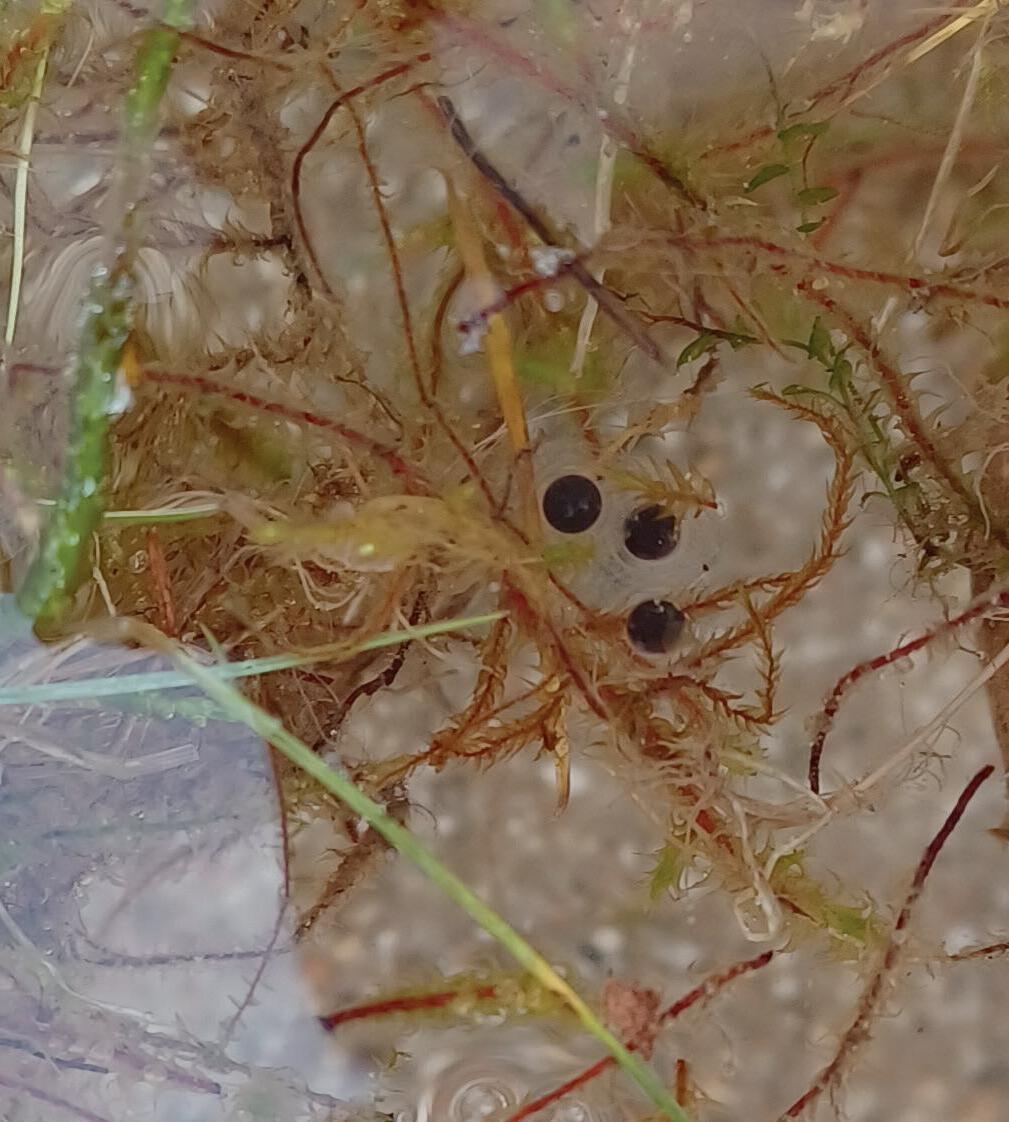
through the nose and the skin. The typical pattern can already be seen on the back, while the belly still appears pale whitish. The first food source of the froglets is the remaining tail, which is gradually absorbed. As soon as it has disappeared - sometimes even shortly before - the young animals eat food. This must now be provided by the keeper in the appropriate size. To get the initially clumsy toads used to the food, it is best if the animals are "well fed" from the beginning. To avoid potential diseases, the food should be varied and rich in vitamins. After six months, the young ones already measure 3-4 cm. After one year they can be socialised with adults without hesitation. It is astonishing that they grow so quickly and also reach sexual maturity incredibly fast; thus, offspring can already be expected in the following year.
What makes care so special
Fire-bellied toads are constantly active and you can always observe them well. However, some species must be officially reported in some countries because they are under protected status. Good husbandry is often rewarded with abundant offspring and healthy animals. Furthermore, fire-bellied toads are excellent for both beginners and advanced terrarium keepers. While the Chinese fire-bellied toad (Bombina orientalis) is perfect for new hobbyists, the small-webbed toad (Bombina microdeladigitora) should be reserved for experienced specialists. The latter is difficult to keep and breed, as it has only recently become truly established in herpetoculture. Thus, keepers should always continue researching the animals, because we are constantly discovering new things about them. We may see fire-bellied toads become even more popular in the hobby in the future. This is because Bombina orientalis have different colour morphs that come out through specialised breeding. New ones appear all the time! So, fire-bellied toads are the perfect terrarium animals!
38 APRIL 2023
Amphibians With Two Sides
Eggs of B. orientalis
Tadpole of B. v. scabra
KEEPER BASICS: OUTDOOR KEEPING
Key considerations for new outdoor keepers
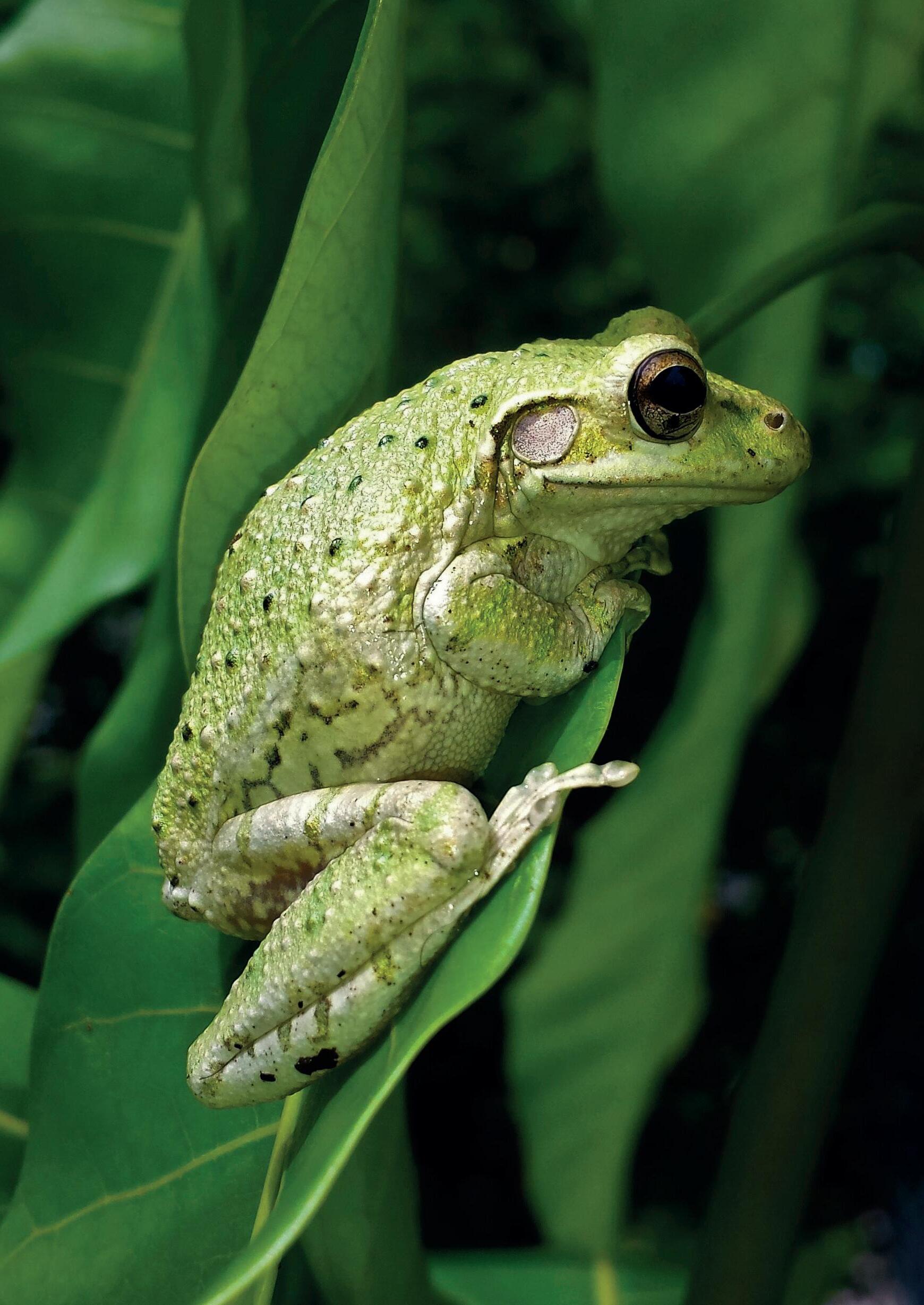
Despite the countless benefits of keeping reptiles outside, the concept of ‘outdoor keeping’ sparks major anxiety in most hobbyists. Full-time outdoor keeping naturally comes with risks. Mortality rates are higher, delicate acclimation is needed and hibernacula must be perfectly positioned. However, when done correctly, outdoor keeping offers the most naturalistic, cost-effective and simplistic methods of keeping reptiles and amphibians. Whilst, indeed, the breadth of species that can comfortably live in European climates is reduced, outdoor and semioutdoor keeping offers an incredible opportunity for herpetoculturists to maintain a vast array of exotic species.
The benefits
Gradients are the cornerstone of good reptile keeping. Even the most beginner-friendly species require a ‘warm’ and ‘cool’ end to their enclosure. Outdoors, temperature, humidity and UVI fluctuate throughout the day, and within a natural circadian rhythm. Furthermore, greenhouse or ‘hybrid’ enclosures can be supplemented or constructed in such a way that consistent hot spots are still available. For the same reasons that many keepers will position their indoor vivaria in the coolest room or garage, starting with a cool ambient temperature and raising a localised hot spot will create a much better gradient than using an excessively hot lamp in an already warm room. Careful positioning of UV-transmitting acrylic can create a sheltered basking spot that remains hot even on cooler days.
There are many considerations the keeper must make before establishing an outdoor enclosure. High walls, bird-proof netting, UV-transmitting acrylic and a deep base to prevent escape are all fundamental to successful outdoor keeping. The keeper must position their enclosures to receive as much sunlight throughout the day as possible, which may not be easy in a smaller garden. Artificial hibernacula are also necessary to protect from frosts throughout the year. These can be as simple as an underground polystyrene shelter filled with moss. Depending on the inhabitants, several hides should be installed at varying depths into the ground. The keeper should familiarise themselves with DIY techniques before embarking on the project and a bit of
40 APRIL 2023
Basics: Outdoor Keeping
Keeper
horticultural knowledge will also prove beneficial to the success of the enclosure. However, once all animals are fully acclimatised, outdoor enclosures offer a simple and rewarding way of keeping. As well as excellent observation and photography opportunities this natural approach supplements animals with natural diets and is an extremely cost-effective (although the initial outlay can be quite high) alternative to indoor keeping.
Whilst indoor keeping is practical with readily available supplies and outdoor keeping is rewarding and beneficial to the animals, there is a third option that marries the benefits of both. Greenhouse keeping is quickly becoming
the crème de la crème of reptile husbandry. With natural fluctuations in temperature, humidity, UV and seasons, as well as a greater level of environmental control by the keeper, greenhouses unlock a new level of captive husbandry. Greenhouses can be kitted out with a myriad of technologies, from misting systems to individual reptibreeze enclosures, supplementary heating, water features, tropical plants and much more. Although glass panels must be replaced with UV-transmitting acrylic, keepers can open and close windows and doors (providing individual enclosures within the greenhouse are secure) to tweak ventilation, temperatures and humidity dependent on the species they are housing.

41 APRIL 2023
Keeper Basics: Outdoor Keeping
A sand lizard (Lacerta agilis) in a custom outdoor enclosure
Considerations for exotic species
Outdoor keeping is nothing new. It has been the preferred method (albeit periodically) for tortoises for centuries and today is still widely regarded as the best method of keeping Mediterranean tortoise species. Although a sheltered area should be provided with appropriate heating, these animals often thrive outdoors. Lacertids, particularly those that have closely related British cousins, or have perhaps successfully established non-native populations here in the UK are also popular. These include common lizards, sand lizards, wall lizards, eyed lizards and green lizards, which are now all readily available as captive-bred animals from outdoor lineages. It is a good idea to keep notes of where these animals have been sourced from. A locale ID will not only identify the hardiest animals but could potentially open doors for conservation in the future and fast-track efforts to prevent non-native populations from occurring, should an animal escape.
There are also a good number of amphibians that can be housed outdoors. European green toads (Bufotes viridis) and fire salamanders (Salamandra salamandra) are some of the most popular and visually appealing. Naturally, these animals should be screened for Chytrid and other diseases. With outdoor keeping creating an increased risk of pathogens being spread, both shops selling animals and the keepers themselves should ideally swab and quarantine their animals before they are sure that they can be released into an outdoor enclosure. From

there, if the outdoor enclosure has been crafted well, the natural weather cycles will create an extremely rewarding breeding process that the keeper can look forward to every spring.
As for greenhouse keeping, similar biosecurity measures should be followed for any species (especially those which may feasibly survive in the wild). When it comes to greenhouse keeping, there is a whole spectrum of exotic species which may thrive in this unique housing. However, the keeper must ask several questions before introducing animals to their greenhouse. Firstly, can the correct temperatures and humidity be achieved long term? In a well-ventilated ReptiBreeze, or across an entire greenhouse, maintaining high humidity can be a challenge. Whilst natural fluctuations will undoubtedly provide some respite, these may need to be supported by a misting system. Secondly, is the captive species capable of destroying the glass or UV-transmittable acrylic? Argentine tegus (Salvator m. merianae) do very well in greenhouse enclosures, however, one firm whip of the tail, or perhaps some dislodged décor and the tegu could easily smash a panel and escape. Even slow-moving species like sulcata tortoises (Centrochelys sulcata) have the potential to damage thin glass and fall victim to the elements. Therefore, it is always a good idea to create an escape-proof enclosure within the greenhouse itself. This could be with reinforced perimeters, or with a mesh enclosure installed in a sunny spot within the greenhouse.
42 APRIL 2023
Fire salamander (Salamandra salamandra sp.)
Ready-made outdoor enclosures
One way of creating a secure greenhouse enclosure is with the ZooMed ReptiBreeze. This sturdy mesh frame is most associated with chameleon husbandry but can be implemented in indoor/outdoor/hybrid keeping in a whole spectrum of ways. It provides excellent ventilation, allows a good amount of UV through its construction, and has a detachable bottom, perfect for cleaning and frequent maintenance. As well as a standalone enclosure in a greenhouse, the ReptiBreeze can be used to extend existing glass terrariums, build enrichment areas, or create temporary enclosures to take indoor animals outside.
The ReptiBreeze comes in several sizes, with dedicated products and replacement parts to ensure that a whole spectrum of species is catered for. Many keepers on the continent, where weather conditions are slightly more favourable than the UK, will house montane species outdoors in Repti-breeze enclosures most of the year. Notoriously difficult to keep species such as Abronia sp, Jacksons chameleons and several agamas will thrive in the well-ventilated, cooler enclosures. This type of keeping, whilst possibly requiring a greenhouse environment here in the UK, is the closest way to simulating nature. UVI levels are not only well-balanced but shift throughout the day as natural day and night cycles ensue. Humidity will peak at night and drop during the day. Water droplets are fresh from the atmosphere and do not require a purification process.
In a greenhouse environment, a misting system can be engineered to catch fresh rainwater from outside and installed directly into the Repti-breeze.
The ReptiBreeze was created to meet the needs of animals who required excellent ventilation. This includes a good number of species that we already know about, but also many which are only just benefitting from the popularity of this new type of enclosure. Jackson's chameleons, for example, have much better mortality rates than when they were first introduced to the hobby as a ‘rainforest’ species. Indoors, the use of a ReptiBreeze enclosure allows for a whole spectrum of species to be housed comfortably and for a reasonably low cost, compared to building a similarly sized, well-ventilated, custom enclosure.
For a quick and easy solution to allow pet reptiles to receive some great natural sunlight and fresh air, Lucky Reptile also produces a mesh enclosure. The ‘Open Air POP UP’ is the perfect instant solution to provide reptiles with some temporary time outside during the sunny weather. It is created from polyester gauze which allows UV to transmit through whilst being light and portable. It can be set up in a matter of seconds and packed away just as quickly, meaning the enclosure can be utilised even in unpredictable weather. With a watertight bottom, the keeper can even spray, or use a damp substrate to increase the humidity slightly, should the ambient RH be too low.
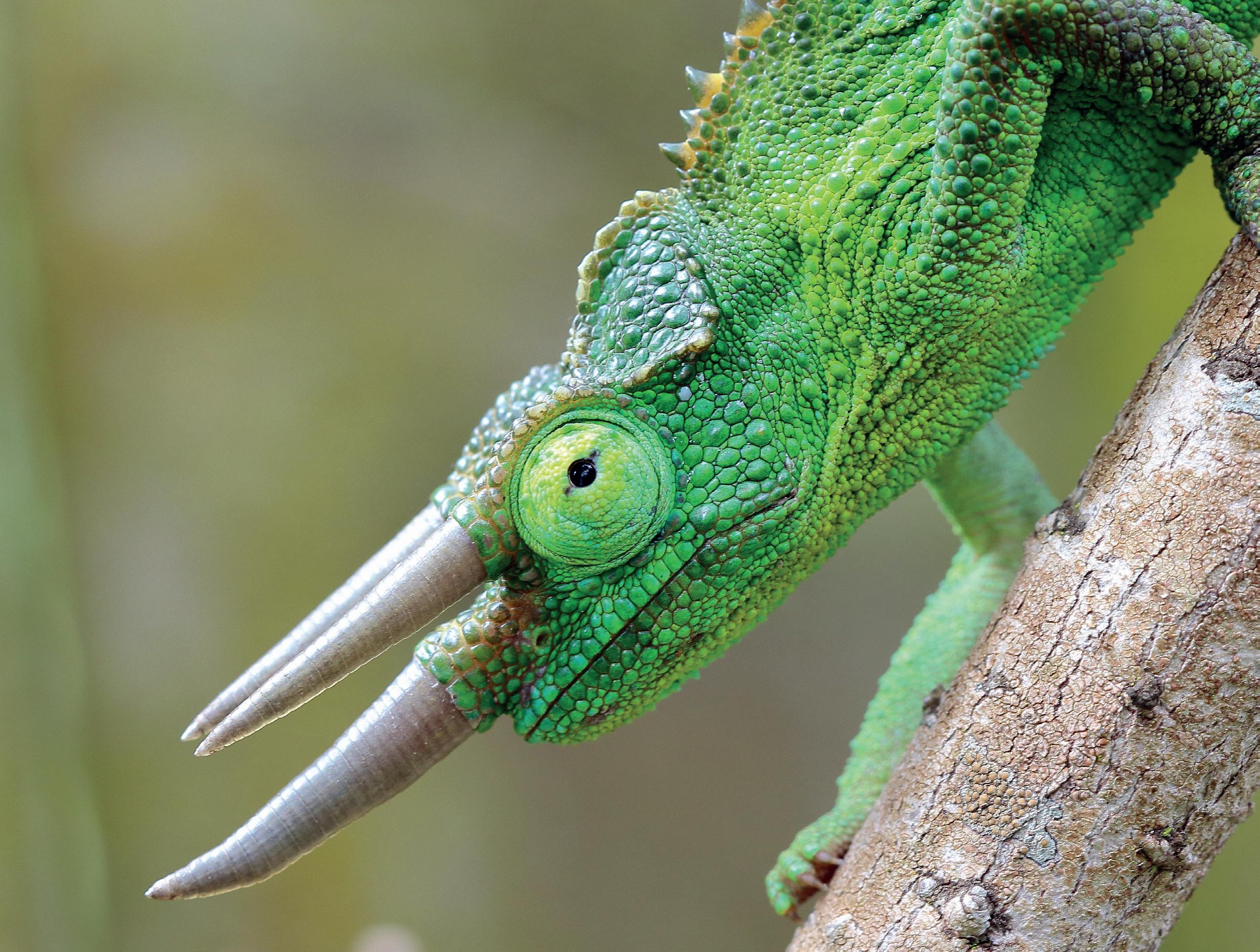
43 APRIL 2023
Jackson’s chameleon (Trioceros jacksonii)
Other considerations
Herpetoculturists are becoming more and more familiar with the necessity of airflow within their enclosures. From fan systems to specially designed ventilation, moving air is an element of nature that we can now install into a captive environment. Of course, with outdoor keeping (both permanent and temporary) now more accessible than ever, keepers should be encouraged to expose their animals to some amount of wind. However, providing a hide or some artificial plants to allow the animal to feel secure and thermoregulate effectively is key.
Choosing the correct time of day to take a pet reptile outside can also be a little challenging. For example, many of the most popular pet reptiles have crepuscular behaviour. These animals generally have very low UV requirements, but taking them outdoors, early in the morning or late in the evening will not provide them with any extra UV. Furthermore, these are likely to be the coolest times of the day and whilst most species should be able to tolerate mild evenings for a few hours, keepers are limited in their options. In this case, the keeper should aim to provide environmental enrichment with the animals ‘outdoor time’. Even if the species is crepuscular,
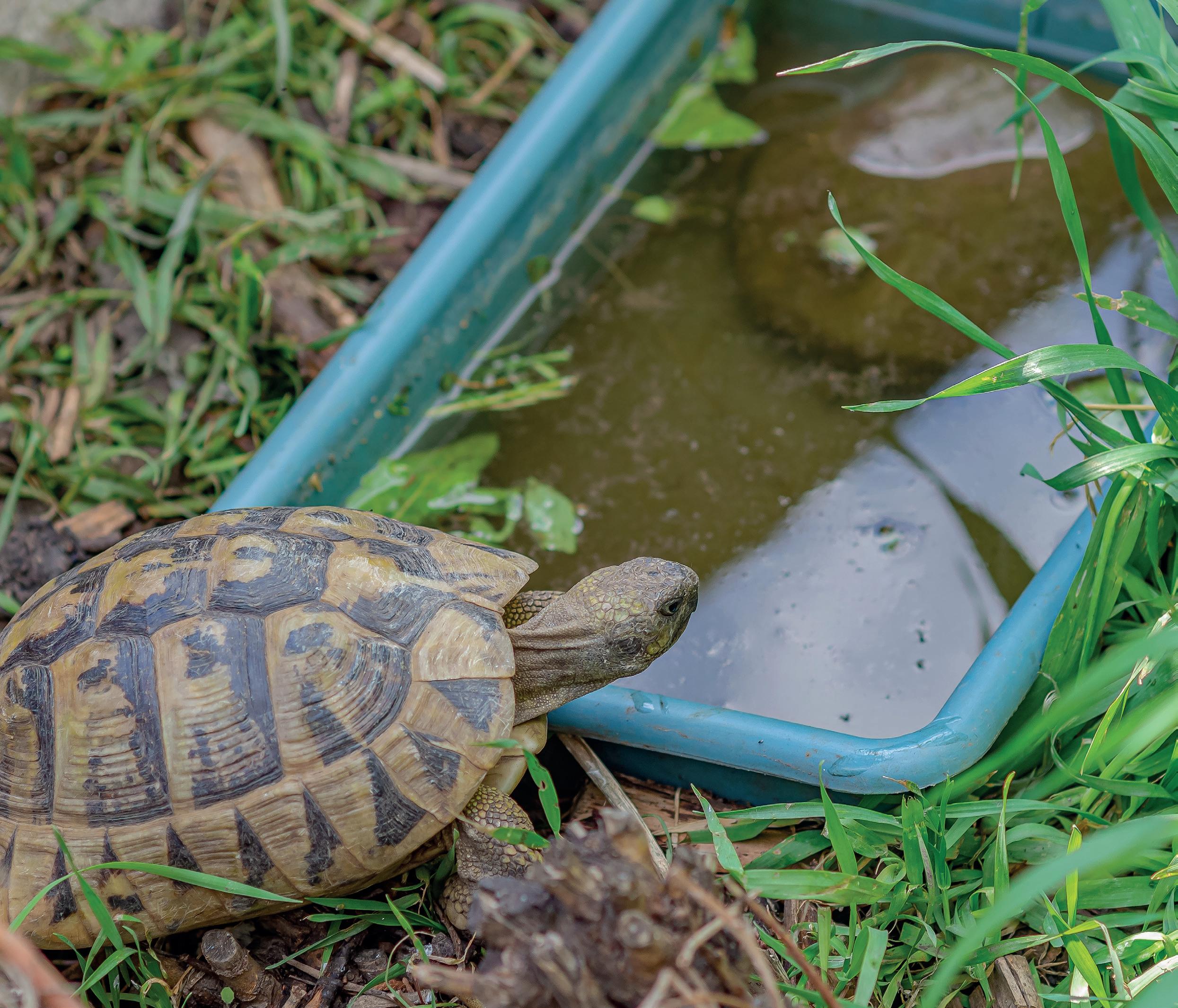
inquisitive behaviour during the day is a good indicator that outdoor time may be beneficial if the keeper can facilitate it. On the other hand, bearded dragons (Pogona vitticeps), green iguanas (Iguana iguana), Argentine tegus (Salvator merinae) hognose snakes (Heterodon sp.), etc, will benefit most from outdoor time in the hottest, midday hours. With many more keepers now working from home, creating a routine throughout spring and summer can help offset some of the impacts on the animals’ circadian rhythm.
Some keepers have taken to walking their pet reptiles on leads. Although large, robust lizards might be less affected, a harness can cause unnecessary strain on the animal. Increased levels of stress are also very likely, as the animal is restrained whilst also conscious of potential predation. Finally, there is an increased risk of disease or illness should the lizard interact with wild animals or feed on pesticide-covered insects. Even though the benefits of taking an active reptile, such as an iguana or tegu on a walk across the countryside may be huge, it is important to evaluate the risks. In this case, a secure ‘playpen’ with lots of stable decor in a pesticide-free garden will undoubtedly be the better option.
44 APRIL 2023
FASCINATING FACT
Fish Facts: Part Two
Fish in the carp family such as goldfish, koi and orfe have pharyngeal teeth in their throats that they use to crush food before it is swallowed. The teeth are very powerful, capable of crushing snails or even freshwater mussels. They can certainly crush your finger if you are foolish enough to put it into the mouth of a large koi or carp. The layout of the teeth in terms of the number of teeth and the number of rows is very specific to each fish and can aid identification.
Freshwater hatchet fish have been reported to fly, or more correctly glide, for up to a meter. The very forked tail allows them to accelerate quickly and jump from the water.
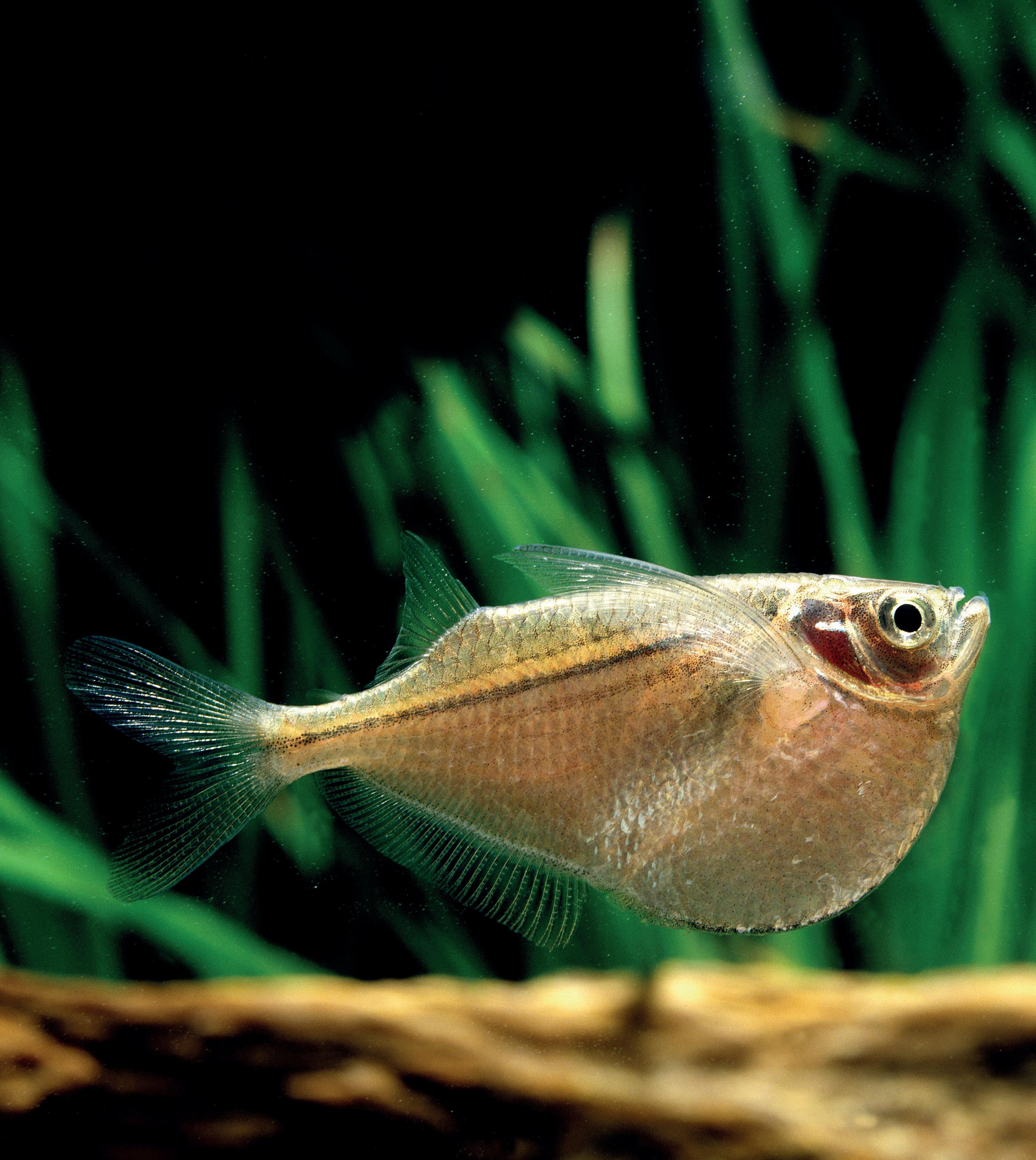
Once airborne the large pectoral fins allow them to glide – usually for a few centimeters, before they drop back into the water.
The mucous layer that covers a fish’s body helps to protect it from parasites, reduces the amount of water that passes into the body and minimizes drag when they swim. Don’t touch your fish with dry hands, nets etc as you can easily remove some of the mucus and reduce the effectiveness of this essential covering.
Fascinating Fact 45 APRIL 2023
REHOME ZONE
Can you help these exotic pets find a new home?

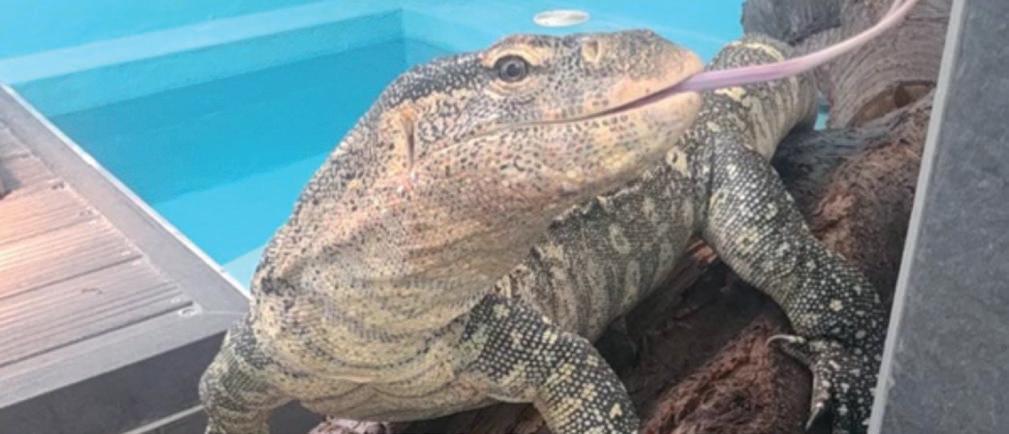
Bart the Burmese Python


Bart is just around 10ft long and has been at RSPCA Brighton since January 2022. Being such a large snake, Bart’s ideal home would be someone with experience working with larger snakes and can house him in an appropriate, zoo type enclosure. The enclosure would ideally need a large filtered and heated pool as well however a large water bowl he can fully submerge in would work if it is cleaned regularly. He needs UVB and overhead heating and a densely packed naturalistic environment with low-lying sturdy branches to allow him to exercise and perform natural behaviours. Being a tropical species, his enclosure would need to be able to tolerate high spikes of humidity.
Bernard the Boa Constrictor
Bernard was picked up by us after his previous owner could no longer care for him. Bernard is about 7 feet long now and, as a large, semi arboreal snake, we are looking for a home that will give him space to display these natural behaviours such as climbing. Due to Bernard's size and typical boa temperament, we are looking to rehome him to someone who already has experience with boas or other large boid species.
Lucio the Ornate Monitor Lizard
Lucio has been with RSPCA Brighton since September now. His previous owner loved him a lot, possibly too much, as he did come into us fairly obese and it has taken him some time to lose weight. He still has some extra weight to shed but is making good progress. Being such a large animal, we would be looking for a home for Lucio with an experienced keeper with a large zoo type enclosure with lots of time and experience to take him on. He requires access to a high basking temperature and a fairly high UVI, a large heated/ filtered water source, sturdy structures for him to exercise and deep substrate. Monitor lizards are extremely smart, alert and aware animals and require someone with a lot of time, knowledge and experience to provide a good enclosure and an enriching environment.
Sam the Chinese Water Dragon
Sam has been at RSPCA Brighton for nearly two years. She is about two feet long and very active. Sam is handleable, although she can be quite skittish at times. An ideal new home for Sam would be with someone who has experience working with lizards, is confident handling them and can give her a large arboreal enclosure (ideally with a pool that is heated and filtered) and has plenty of sturdy branches and plants for her to climb on. She will need appropriate overhead heating and UVB lighting being an Asian species.
Jesus the Green Basilisk
Jesus has been with us over 600 days now, since April 2021. He is very active and curious and so he is looking for a home with someone who can provide him with a large enclosure. He will need a large and filtered pool, plenty of branches and plants to climb on with overhead heating and UVB. Jesus is about a foot and a half long and is growing steadily.

46 APRIL 2023
Rehome Zone Contact RSPCA Brighton: reptiles@rspcabighton.org.uk or call or message on whatsapp at 078155278 between working hours of 9am-4pm.
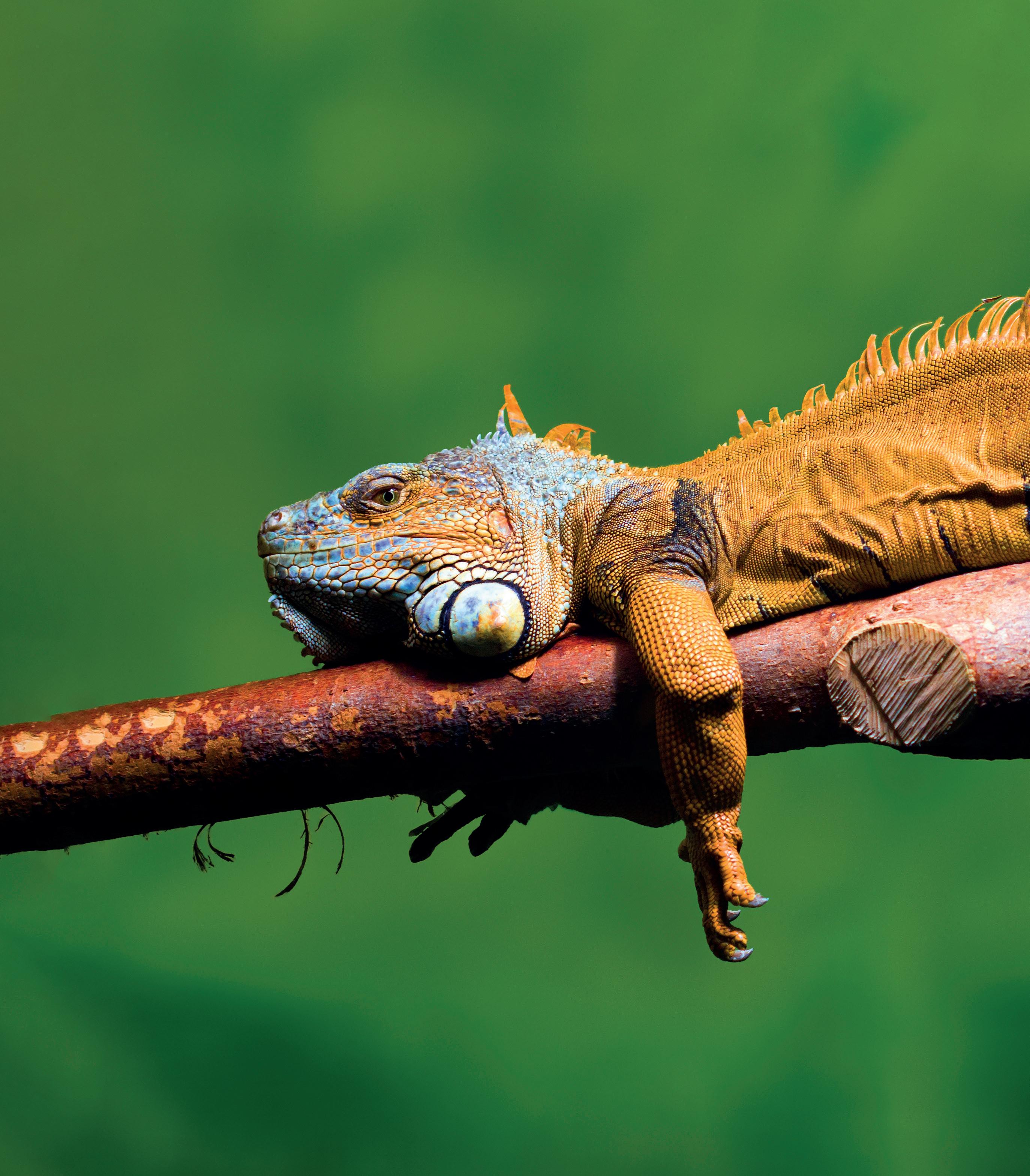
47 APRIL 2023 Rest Easy. Don’t lift a claw! Your current exotic insurance cover will stay the same. And we are on hand to help should you need us. We also offer exotic, dog, cat and horse insurance, as part of the Petcover Group. Contact us at exoticdirect.co.uk or call us on 01444 708850. ExoticDirect is a trading name of Brooks Braithwaite (Sussex) Ltd which is registered in England and Wales under number 1416900. Brooks Braithwaite (Sussex) Ltd is authorised and regulated by the Financial Conduct Authority under reference number 304839.



 of the genus Bombina and long-eared hedgehogs. pipe dream or is there any science behind it?
of the genus Bombina and long-eared hedgehogs. pipe dream or is there any science behind it?




































































































































































 By Rosie Smith.
By Rosie Smith.







 By Bryan Minne and Laura Ruysseveldt (Herpetological Education & Research Project)
By Bryan Minne and Laura Ruysseveldt (Herpetological Education & Research Project)










 With Two Sides
With Two Sides

























